The opening ceremony and forum of the "Architecture of Nature" solo exhibition by Zhu Pei were successfully held at the He Art Museum in Wuhan.
2023.07.20
On June 29, 2023, the "Architecture of Nature" solo exhibition by Zhu Pei opened at the United Art Museum in Wuhan. This is the first solo exhibition in China by the renowned architect Mr. Zhu Pei, and also the first solo exhibition by an architect that the United Art Museum has held in its nine years of establishment.
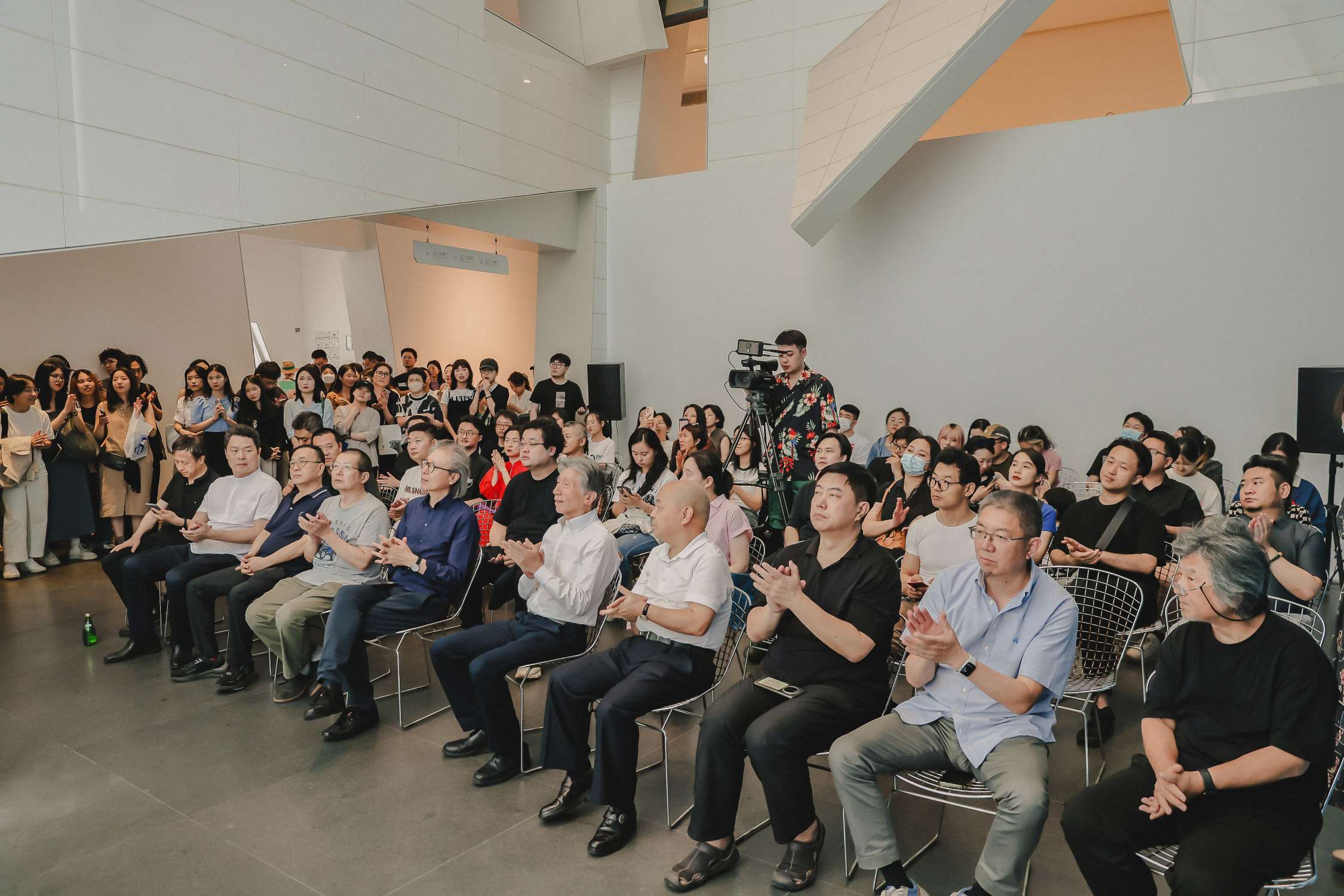
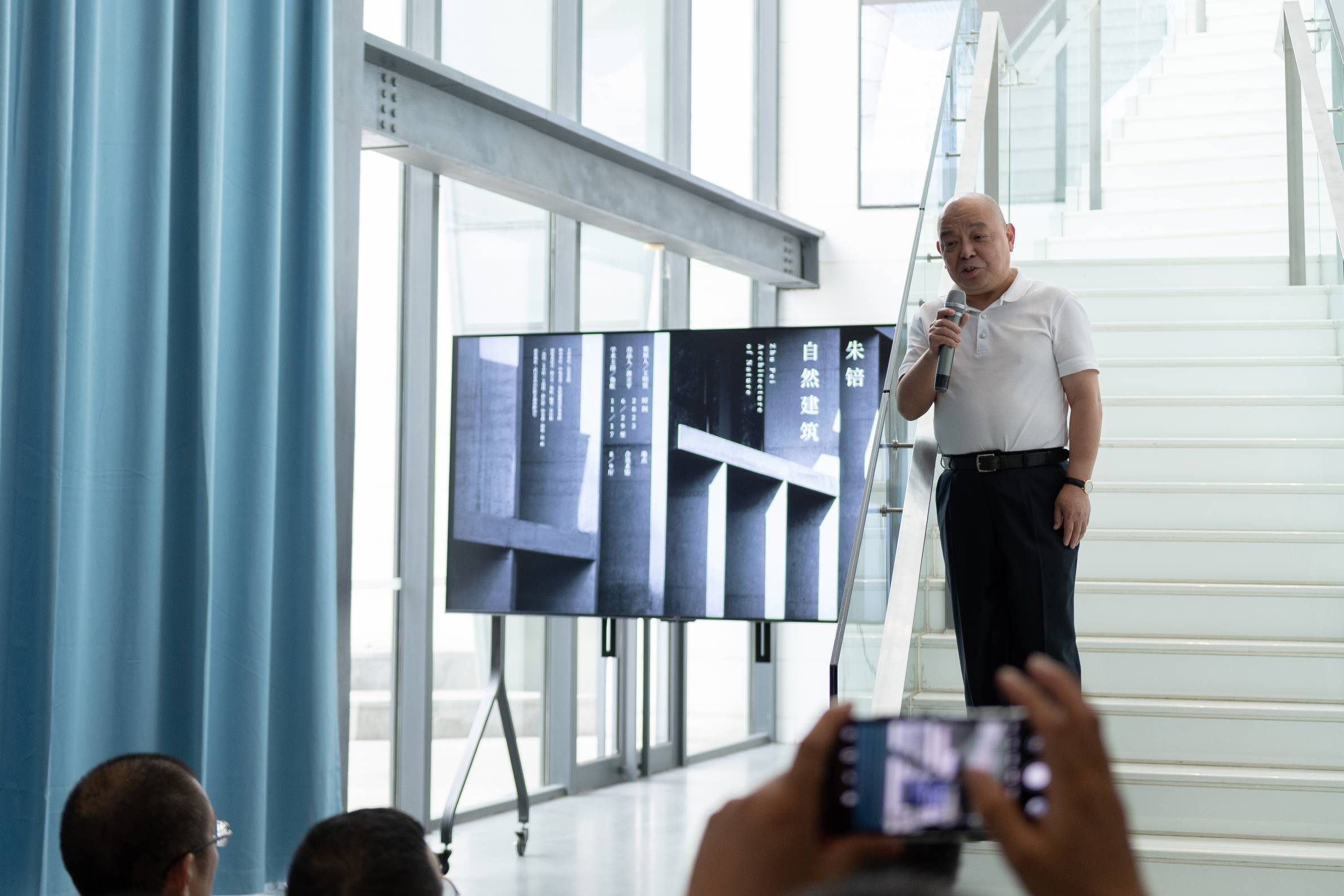
In the opening speech, Mr. Huang Liping, the director of the United Art Museum, first reviewed the history of the museum's establishment and the initial intention of choosing to establish a contemporary art museum as an entrepreneur. It was not only to promote the sustainable development of enterprises based on culture, but also to truly participate in current social development and life, to promote future-oriented art development with the spirit of daring to doubt and breakthrough. In nearly a decade of its history, the museum has held solo exhibitions for 22 contemporary artists and has also gradually realized the importance of contemporary architecture during this process. Therefore, the idea of hosting a series of solo exhibitions for contemporary architects has become increasingly mature. The decision to choose Mr. Zhu Pei as the representative architect for the first exhibition was because they saw in Zhu Pei's works the criticality and transcendence that is in line with the spirit of contemporary art. The contemplation on culture and the Eastern view of nature embodied in his works holds particularly enlightening significance in the present day.
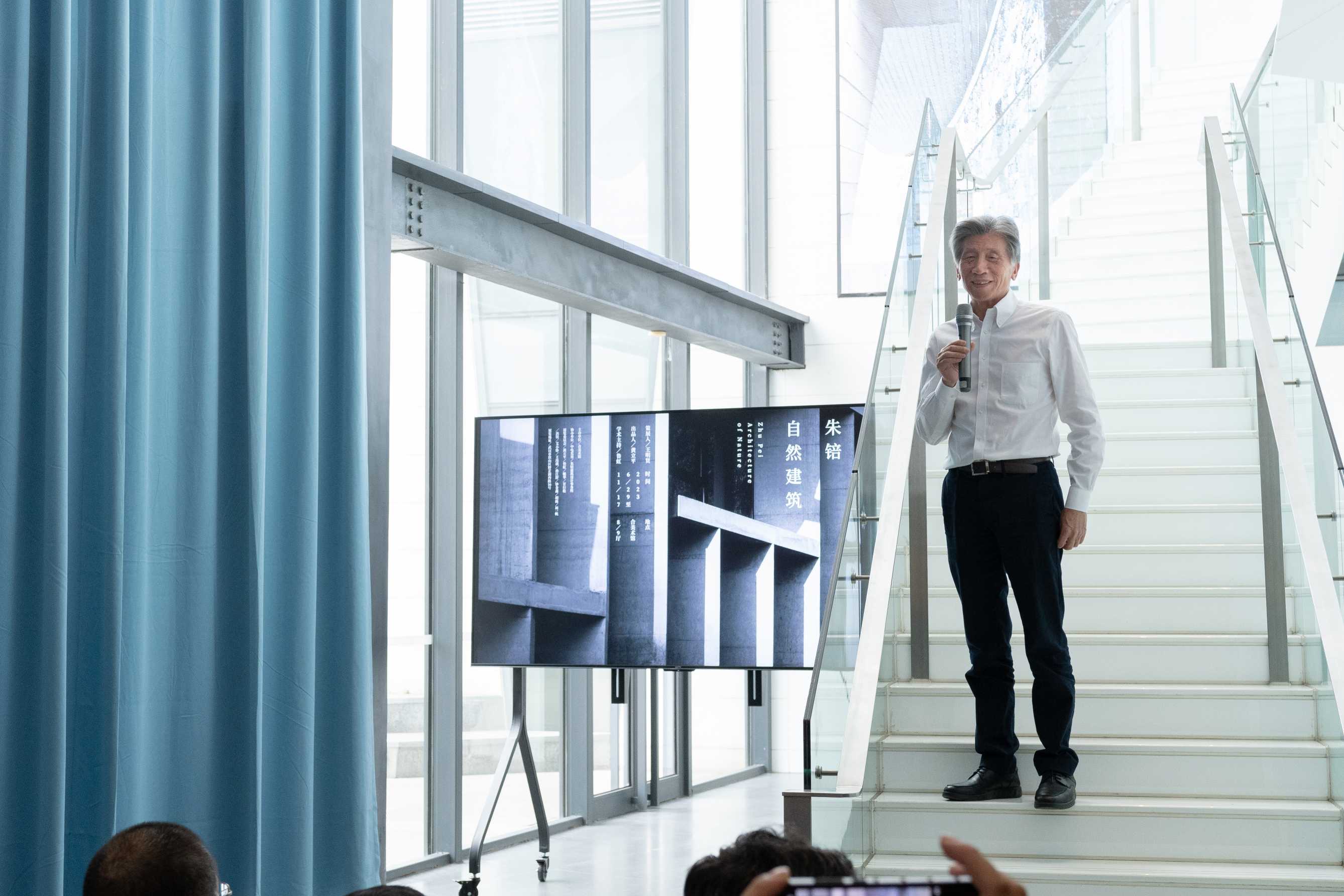
Mr. Fan Dian, Chairman of the China Artists Association, was also invited to attend the opening ceremony and gave a speech. He highly praised Zhu Pei's experimental architectural creations and the concept of "Architecture of Nature" from a theoretical and academic perspective:"Mr. Zhu Pei is a world-renowned Chinese architect. For many years, he has persisted in theoretical thinking and exploration, and has demonstrated the cultural thinking, cultural vision, and relentless exploration of contemporary Chinese architects through a large number of architectural practices. Many of his works are showcased in this exhibition, forming an elegant academic atmosphere through models, manuscripts, and images, and are particularly artistically appealing.In my view, Zhu Pei is a very typical architect who crosses cultural boundaries. He has carried out exchanges from China to the United States and many other places around the world, conducted teaching, and formed project collaborations. However, his architectural practice is always rooted in the land of China. He has deeply studied the expression of Chinese traditional architectural thoughts, concepts, and cultural spirit in contemporary architecture, forming an architectural concept based on his own cultural tradition.The concept of "Architecture of Nature" he proposed is of significant importance for us today in reviving Chinese culture in the field of architecture. Just as Director Huang Liping just said, we have many experimental and exploratory architectural practices, which need to become more inclusive and a broader frontier trend in architecture as a whole today. Mr. Zhu Pei has given us profound enlightenment in this regard."
Mr. Fan Dian summarized three important features of Mr. Zhu Pei's architectural philosophy and practice:
First, the exploration of "Architecture of Nature" not only associates architecture with nature but also relates it more closely with human culture. This makes "humanistic nature" further enrich the connotation of "nature" in terms of cultural capacity and texture.
Second, "Architecture of Nature" is the crystallization of combining function with cultural thinking and then exploring. It integrates architectural function with natural culture using the language of architecture, and manifests it with creative spatial expressions, thus unfolding infinite spiritual dwellings in a limited space.
Third, "Architecture of Nature" conducts in-depth exploration and groundbreaking inheritance of traditional Chinese construction methods and material applications from the perspective of specific construction techniques.
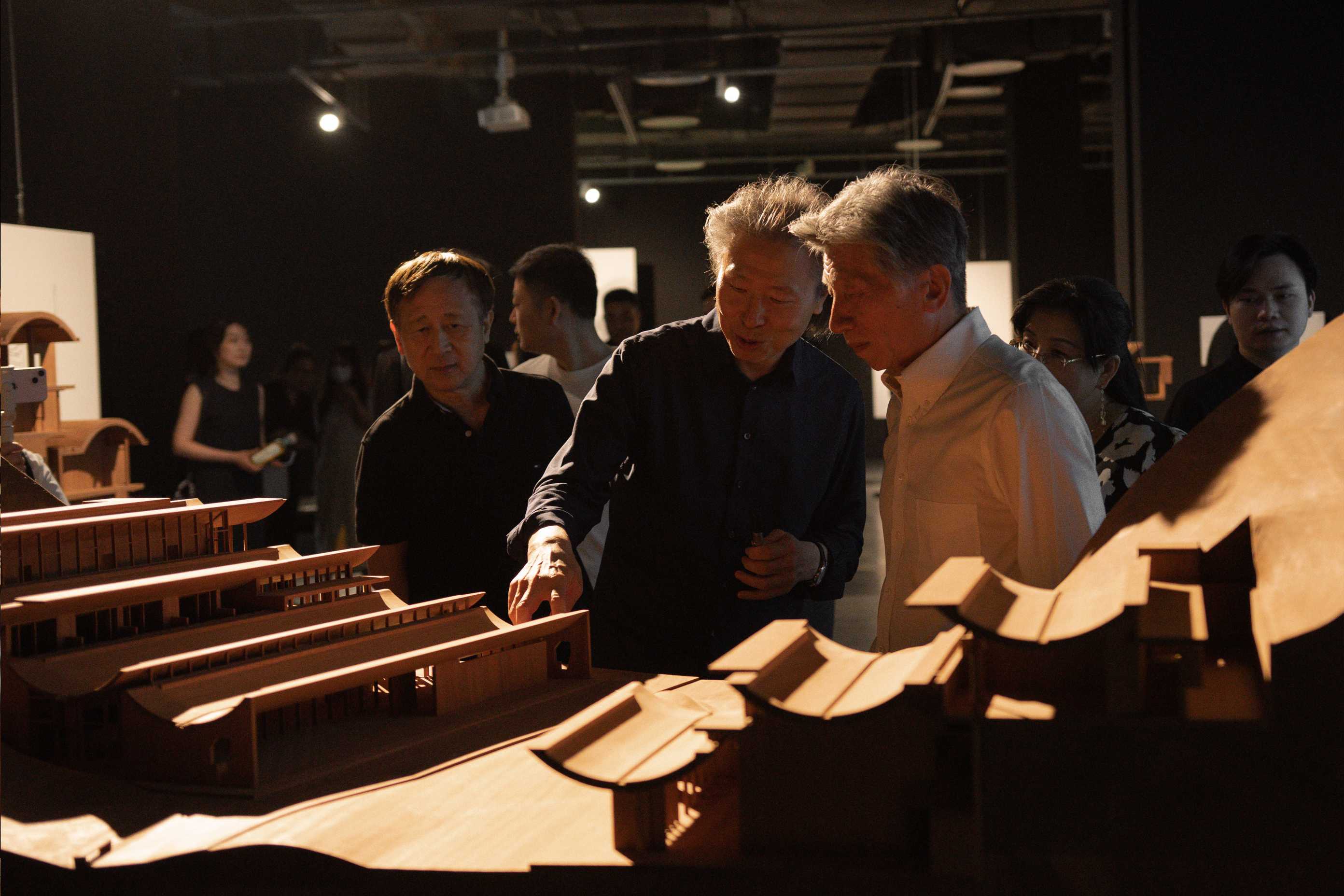
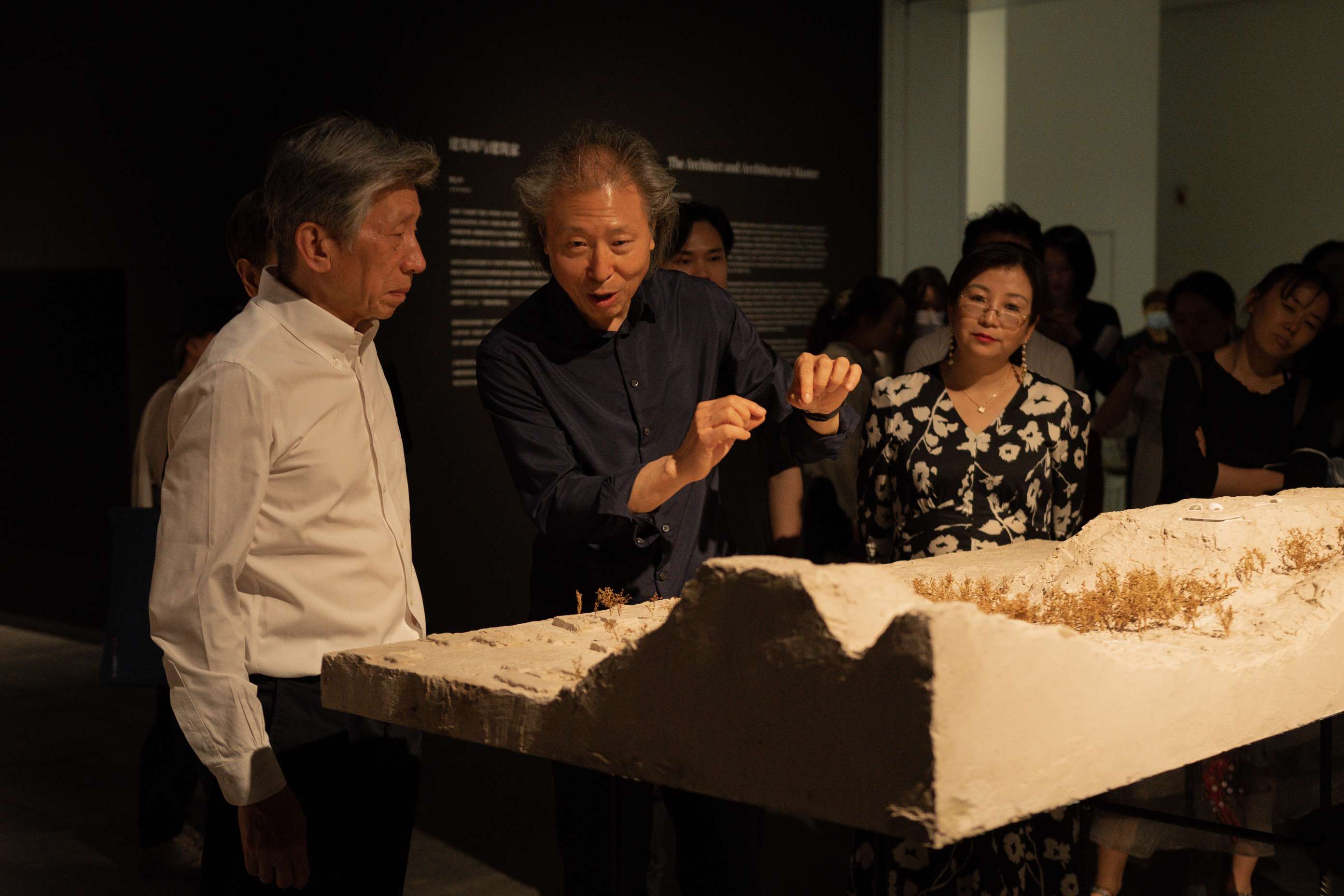
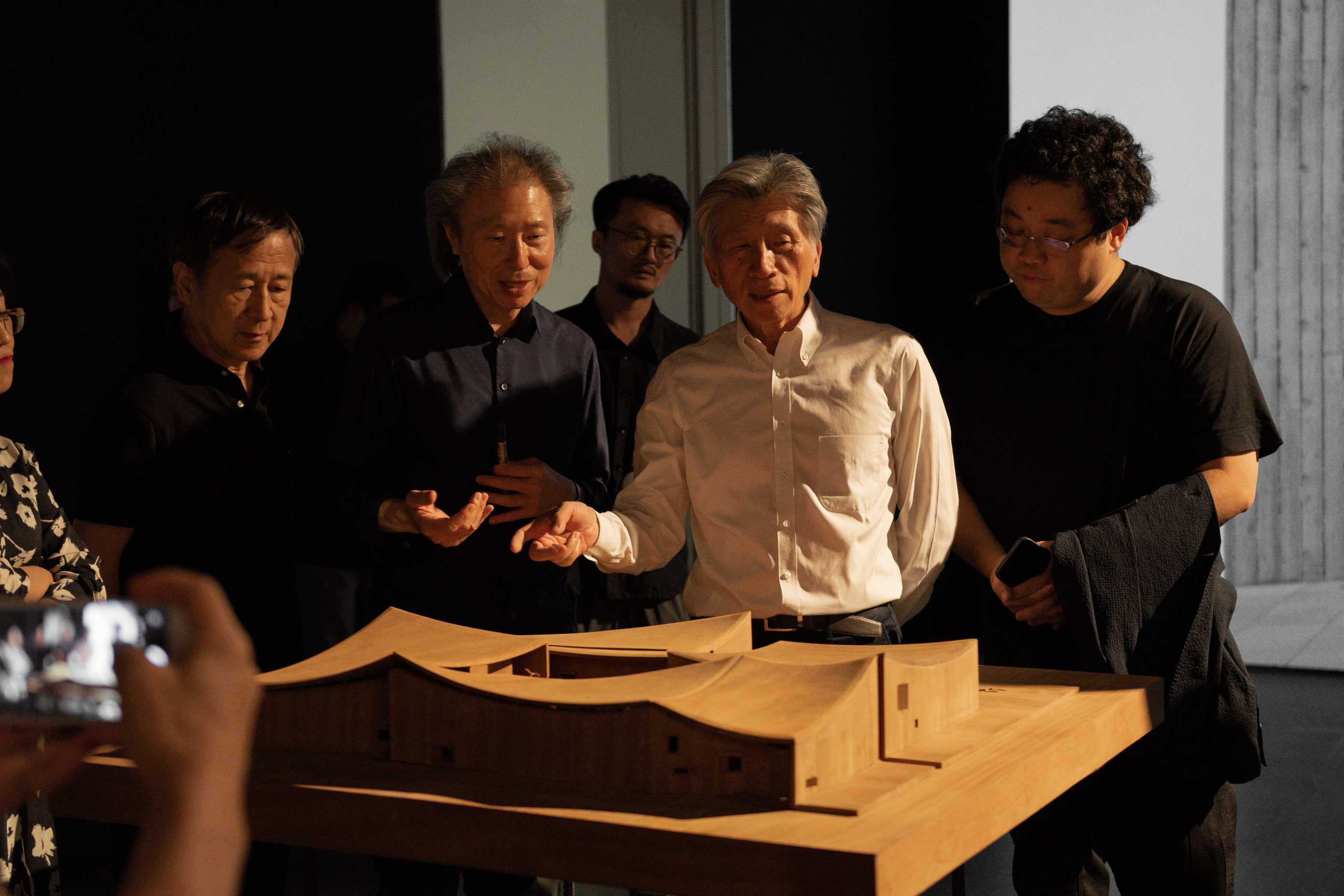
Mr. Wang Mingxian, the curator of this exhibition, was unable to attend the event in person. Ms. Yao Hua, the deputy director of the United Art Museum, delivered the opening speech on his behalf. The speech reviewed the historical background of the emergence of "Architecture of Nature" from a historical perspective and reiterated the significance of the theory of "Architecture of Nature" - it represents a rare experiment in world contemporary architecture, and an important supplement to the world's architectural theory.
In his speech at the opening ceremony, the exhibiting architect Mr. Zhu Pei mentioned: "During the past decade or so of experimental creation, I have always adhered to my architectural philosophy -- the theory of 'Architecture of Nature'. It is based on the cultural perspective and my perception of natural landscapes and human construction culture. 'Architecture of Nature' is, on one hand, a poetics of construction culture. On the other hand, it is also a response to two major challenges faced by humans today -- 'global climate change' and 'regional cultural disruption' -- based on traditional Eastern philosophy of nature."
"The 'Architecture of Nature' solo exhibition at the United Art Museum in Wuhan is, on one hand, a continuation of the thoughts on 'Architecture of Nature' derived from various domestic and international exhibitions I have participated in, including the 'Yi Garden' at the 2010 Venice Biennale, 'Mind Landscapes' in Berlin in 2017, 'Transformation' at the Imperial Kiln Museum in Jingdezhen in 2020, and 'Reuse, Renew, Recycle: Recent Architecture from China' at the MoMA (Museum of Modern Art) in New York last year. On the other hand, it is also a reflection, introspection, and summary of my own architectural creation process in recent years."
He first expressed his gratitude to Mr. Huang Liping, the director of the United Art Museum, and Mr. Lu Hong, the executive director, as well as their excellent team, for inviting him to hold a solo architecture exhibition at the United Art Museum - the forefront of contemporary art in China. He thanked them for their attention to contemporary Chinese architecture and appreciated their experimental, critical perspective and courage.
He specifically mentioned: "Looking back at my experimental creation and teaching career, I sincerely thank Mr. Fan Dian and Mr. Wang Mingxian for their long-term support, help, and guidance in the past twenty-plus years of teacher-student and friendly interaction. It is their long-term help and encouragement that allowed me to focus on contemporary art and draw energy from it, gain inspiration between contemporary architecture and contemporary art, and form my own distinctive creative language. I also want to thank Professor Zhou Rong for the criticism and help given to my experimental creative works over the past thirty years of friendship."
Lastly, I want to thank my colleagues, companions in my studio, and my students from the Central Academy of Fine Arts. It is your outstanding work and talented creativity that have made today's exhibition possible. Thank you all.

At the end of the opening ceremony, a donation ceremony was held, during which Mr. Zhu Pei accepted the donation certificate issued by Director Huang Liping.
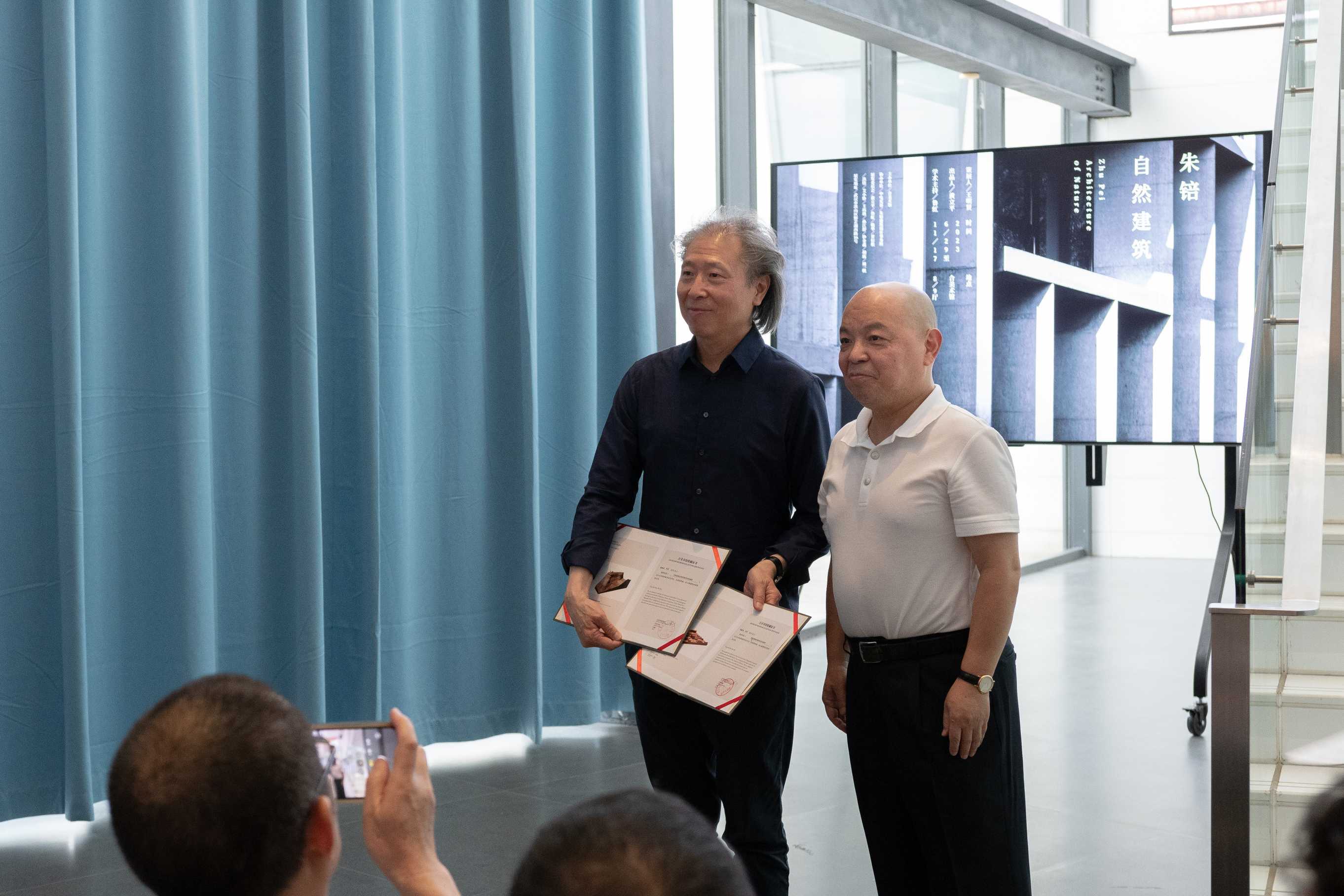
On the morning of the opening ceremony, the "Architecture of Nature" Forum was also held. Renowned scholars, architects, critics, and artists from across the country gathered to express their views on the related topics of "Architecture of Nature". Through these exchanges, the concept of "Architecture of Nature" was more fully explored.
Mr. Zhu Pei first led the guests on a tour of the exhibition, emphasizing that the "Architecture of Nature" solo exhibition held at the United Art Museum in Wuhan is a continuation of the concept of "Architecture of Nature" embodied in several exhibitions at home and abroad, including "Yi Garden" at the 2010 Venice Biennale, "Mind Landscapes" in Berlin in 2017, "Transformation" at the Imperial Kiln Museum in Jingdezhen in 2020, and "Reuse, Renew, Recycle: Recent Architecture from China" at MoMA in New York in 2021. It is also a reflection and summary of his own architectural creative process in recent years. He mentioned: The creative process of architects is different from that of most artists. Artists often create facing their own final works, while architects can only create with the aid of media. In this "Architecture of Nature" solo exhibition, only three media - sketches, models, and images - are used to realistically and artistically reproduce the creative process of the architect and the thought behind the works.
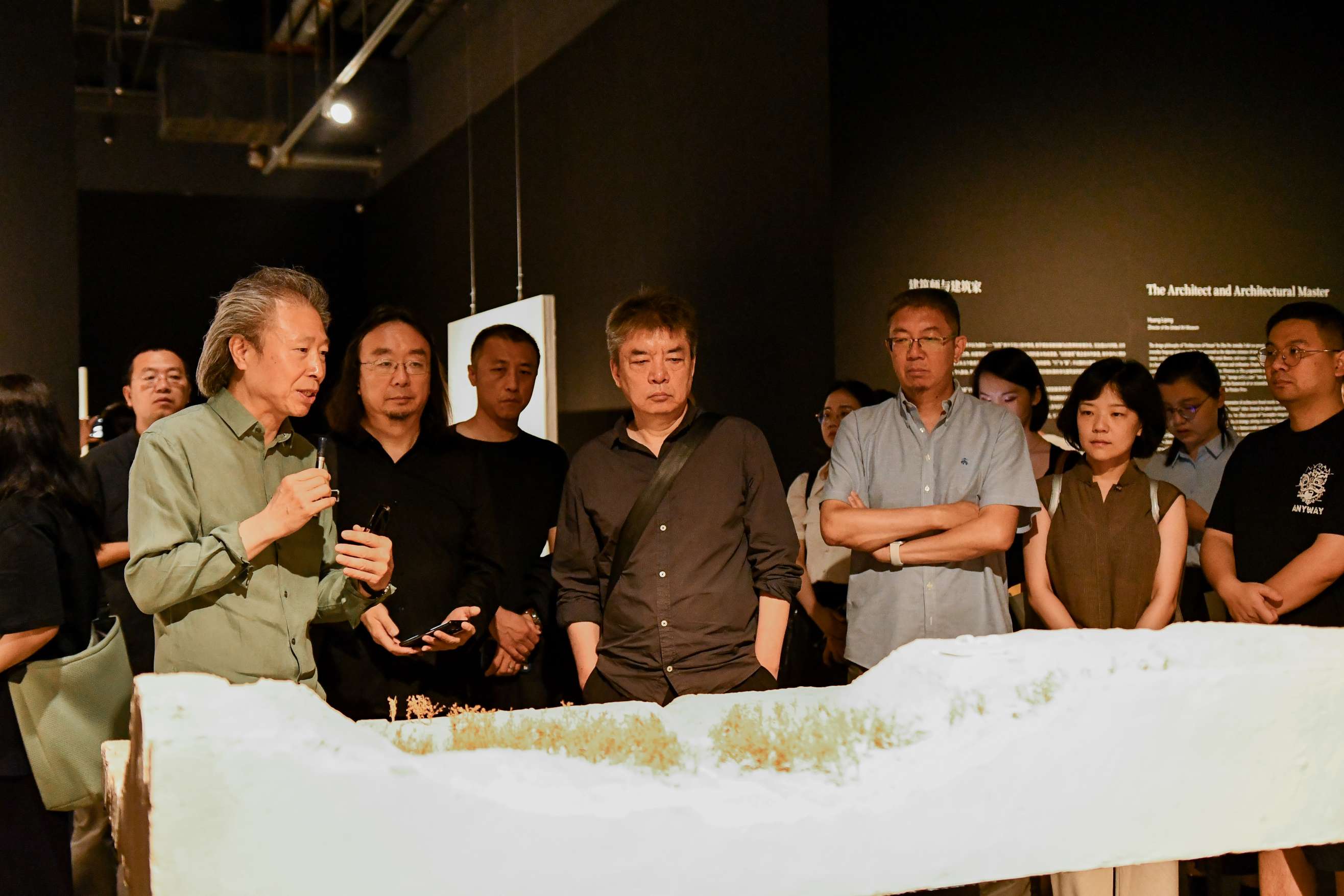
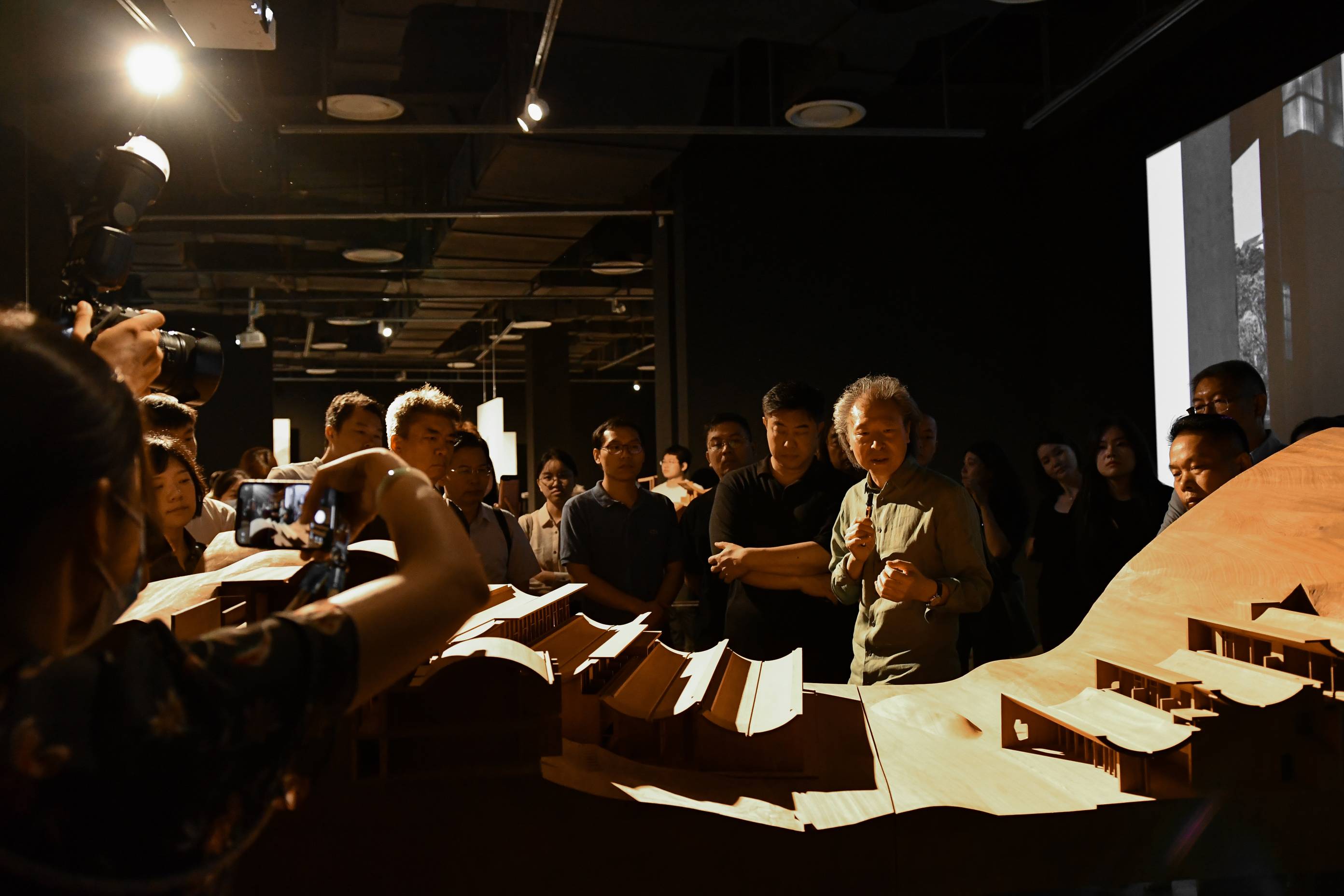
At the beginning of the forum, Mr. Zhu Pei gave a keynote speech, in which he elaborated on the theory of "Natural Architecture" in conjunction with five exhibited works. "Natural Architecture" is a realization by Zhu Pei based on a cultural perspective on natural landscapes and human construction culture. On one hand, it is a construction poetics; on the other hand, it is a response to the common challenges faced by humans: global climate change and regional cultural disruption, both of which are responses rooted in Eastern natural philosophy. What it explores is the underlying construction principle of architecture, seeking a kindred relationship between people, nature, and culture. Its ultimate goal is to explore the poetic dwelling of human beings in the world.
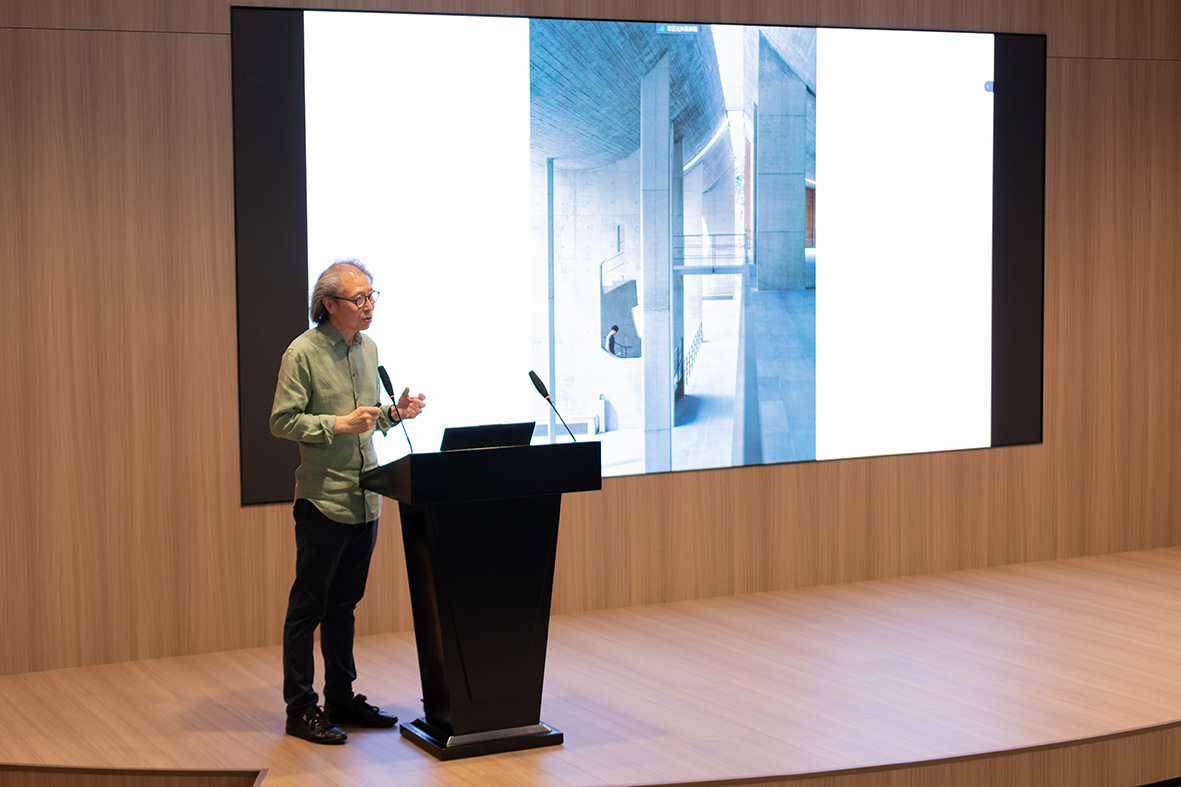
"Rootedness" and "Creativity" are the dual paths from theory to practice in "Natural Architecture". On one hand, by excavating roots, architecture can be grounded in a certain specific climate and cultural soil. On the other hand, a creative attitude allows architecture to shape an open system that accommodates many new possibilities and creates new experiences. "Rootedness" is not only about digging into and understanding the past of past things, but more importantly, it's about understanding the present nature of past things. If an architectural work does not have the "rootedness" of historical consciousness, it would be like having no fulcrum in the vast cosmic space, incapable of leveraging the existing architectural thought system, hence there would be no talk of "creativity".
To be specific, "Natural Architecture" proposes to examine architecture from five dimensions, which are: 1. Site and Orientation, 2. Structure and Form, 3. Sponge Architecture, 4. Cave and Nest, 5. Incomplete Integrity. These dimensions not only reveal the profound blood relationship between traditional culture and contemporary architectural creation from the perspectives of construction and technology, but also from the perspective of culture. The deep relationship reflected by these dimensions is our attitude towards humans, nature, and tradition. In the current context where architecture is increasingly polarized between theme-parkization and commodification, it is particularly important to maintain a historical view that respects nature, tradition, and the history of humans themselves.
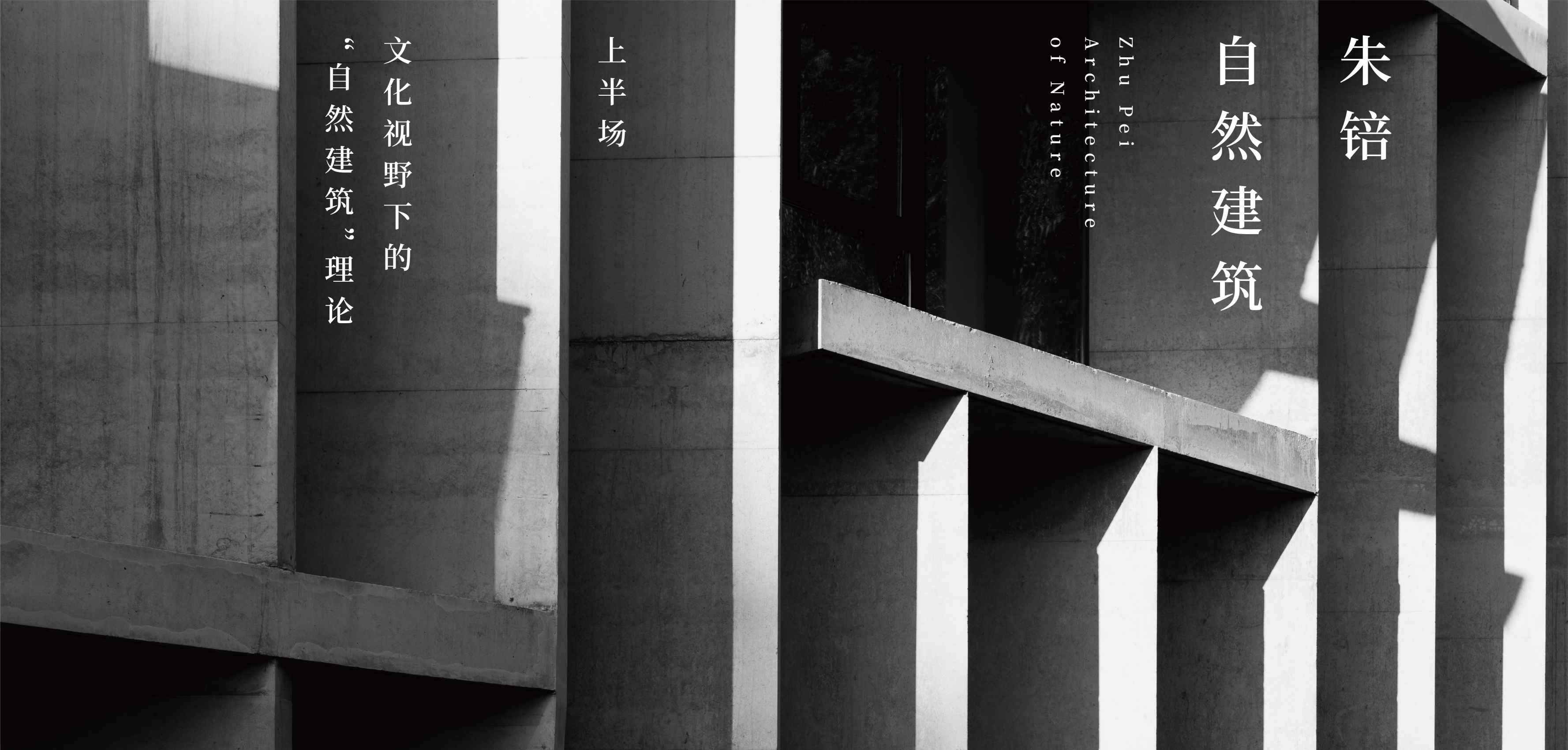
The first half of the forum, themed "Natural Architecture from a Cultural Perspective", was chaired by Professor Li Xiangning, the dean of the School of Architecture at Tongji University. The four guests, hailing from fields of architectural history and theory, architectural media, mass media, and contemporary art, expressed their views and understandings of "Natural Architecture" from various perspectives.
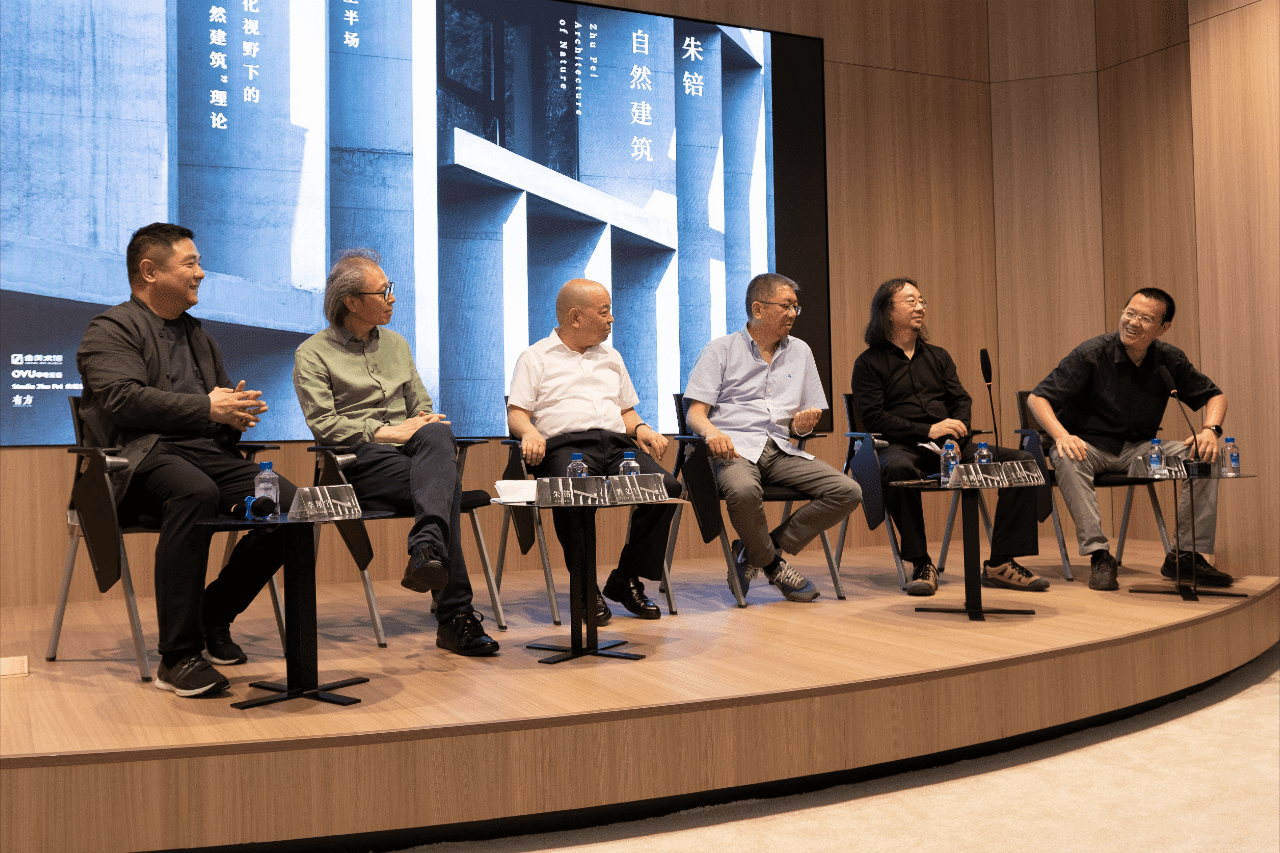
Li Xiangning:
Contemporary architecture often holds great appeal for contemporary artists, leading them to be eager to engage in architectural creation. As a curator of a contemporary art museum, how do you view the practice of contemporary architecture in China? And how do you evaluate Zhu Pei's "Architecture of Nature"?
Huang Liping:
Firstly, you mentioned the idea of contemporary artists wanting to replace architectural design, but this is probably more of an artistic imagination because architecture, apart from its artistic aspects, also has functional and economic needs. Without considering these aspects, architecture cannot be realized.
From the perspective of an art museum, as knowledge creators producing knowledge, we hope that contemporary art not only does not overlook architecture but also gives it sufficient status because what is influencing this era is likely not only painting and sculpture but to a large extent, architecture. In this sense, "Architecture of Nature" is something we eagerly anticipate as a narrative theme that can be found through Eastern culture and spirit. The "Incomplete Integrity" dimension in the five dimensions of "Architecture of Nature" establishes a connection with the "non-necessity" that I have greatly admired in the past. If everything is necessary, there would be no art because art arises from the non-necessary. In this respect, we find a common ground in our thinking, and this exhibition is a very good start. I hope it can continue and contribute to Chinese architectural culture and practice.
Li Xiangning:
Different from architectural media, Sanlian Lifeweek pays more attention to the relationship between architecture and society and people - what impact does it have on local residents or users? What significance does it have in changing the overall urban human ecology? From this perspective, as the editor-in-chief of Sanlian Lifeweek, how do you evaluate Zhu Pei's architecture?
Li Honggu:
In a sense, architecture is the fundamental basis for narrating a region and a city. Whether architecture can serve as the source for telling the so-called Chinese story and urban story, Zhu Pei has done a very powerful job. Take Jingdezhen as an example. The previous narrative of being the "Millennium Porcelain Capital" was actually broken in terms of time because the Millennium Porcelain Capital neither led to the emergence of commercial civilization nor achieved the realization of scaled commodity production, resulting in the city not finding its own narrative roots and sources. I believe that it was only after the completion of the design works by Zhang Jie and Zhu Pei that the urban narrative of Jingdezhen was fundamentally reconstructed, turning to its own cultural roots. History in their construction is continuous, inherent, and self-consistent. Specifically, in the design of the Jingdezhen Imperial Kiln Museum, it delves into the internal structure of kilns rather than just the porcelain itself. It respects and draws wisdom from traditional construction, returning to the continuity of local tradition and the development of porcelain production itself. It integrates into the urban context and fabric, rather than being a monument-like abrupt presence. At the same time, on the other hand, it is both innovative and poetic in terms of structure, occurring in the present with historical significance, providing a future that is both continuous and open, creative and uncertain.
The concept mentioned by Zhu Pei in his exposition of "Architecture of Nature" is crucial, which is the "presentness in the past." I remember when I first met Zhu Pei at the Jingdezhen Imperial Kiln Museum, I asked him why the two ends of the kiln structure were connected. His answer was very simple: for convenient ventilation. This straightforward response struck me as having a Zen-like quality. As a person from the southern region, it embodies the most basic and simple knowledge of southern life. From this, I understand that the "rootedness" in "Architecture of Nature" actually lies in these local and ordinary traditions, and this is also the aspect that truly moves ordinary people like me living in such a city.
Li Xiangning:
Professor Zhi, you are conducting research on the genealogy of Chinese architects, observing the professional ideas and academic trajectories of architects. Zhu Pei's early works in the Shenzhen Planning Bureau and the Shenzhen OCT Art Center are very different from his current works. From your observation of the development of an architect's career, why did Zhu Pei undergo such a transformation?
Zhi Wenjun:
Looking at Zhu Pei's generation from the perspective of contemporary Chinese architecture, as the fourth generation of architects, they were fortunate to have many opportunities, such as studying abroad after the reform and opening up and later participating in the great wave of Chinese architecture. In my opinion, Zhu Pei is an excellent architect based on the core of modernist architectural space. The "Architecture of Nature" he currently speaks of not only presents the fundamental characteristics of modernist space but also gradually explores new aspects such as the extension of space as a body and the expression of spatial history and culture. Compared to the early Shenzhen Planning Bureau Office Building, as a modern architecture, it expresses something different in terms of the history, climate, culture of the local area, and the intensity of space he currently speaks of. As a creative subject, architects have endless possibilities in their thinking about the infinite potential of each individual's mind-body experience and the pursuit of sensory perception of space. But as long as a building evokes emotions in people, and these emotions come from the unique value of its local history and culture, then it is a great architecture.
Li Xiangning:
Zhu Pei analyzed "Cave and Nest" as types or prototypes of architecture. Cave and nest represent two architectural models in the West, reflecting two different relationships between human beings and nature in the process of survival. One relies on nature, using caves to provide a warm environment, and the other is when nature does not provide, humans build using branches. These two have a certain opposing or complementary pattern, similar to the Platonic model in philosophy, where the cave is used as a metaphor for humans, actually confined within their own narrow cognition. For architecture, it also faces this issue, on one hand, its own cognition, and on the other hand, its understanding of nature. To some extent, Zhu Pei's exploration is the struggle or search for balance between the two extremes. Please share your understanding of this issue.
Qing Feng:
This question has many theoretical clues, and the question itself is very inspiring. "Nature" is the most traditional concept in architecture, and the entire classical theory is built on the concept of natural order, which continued until the Renaissance. The Renaissance also studied nature and understood it as an absolute order. Therefore, creation is not so arbitrary; one must find this absolute theory and present it.The concept of nature has changed throughout history. In the 18th century, philosophers like John Locke and Jean-Jacques Rousseau discussed nature as the natural state of humans, as innate competition or human nature being inherently good. Therefore, in Marc-Antoine Laugier's Primitive Hut, it is humans who construct, rather than the rules imposed by the heavens. At this time, the concept had shifted from an absolute natural order to the natural state of humans, and humans became the dominant force. Since then, modern science has been built on human-led science.In "Architecture of Nature," an important concept is rootedness, and Martin Heidegger's understanding of nature is actually about rootedness, which he calls the “spring”. Heidegger used the concepts of sky and earth because they are closest to nature. The term "Nature" that we use today is borrowed from Japan; before that, it was translated as sky and earth, which is closer to Heidegger. The difference between them is that most scientific explanations of nature today, analyzed through technological perspectives, can't explain many things. Although they can't explain them, they still serve as a source, which makes people feel that we should maintain a sense of humility and respect. "Architecture of Nature" also mentions the concept of incomplete integrity, and its roots lie here. Incompleteness is inevitable because it comes from nature. Nature, in Western etymology, means birth, it comes from the word embryo. It is something that is born, not something created out of nothing. Today, the most common understanding of artists is that they are creators, but in reality, the only true creator out of nothing is God. If we are not God, we cannot do it. Regardless of materials, structures, or traditions, they are the sources that we cannot escape. On the other hand, precisely because we have this source, the work has a foundation and profound connotations that can be understood and communicated, thereby constituting a kind of completeness from another perspective. From this perspective, concepts like "Architecture of Nature," including the five related factors mentioned earlier, are very important. We are not just talking about architectural design techniques, but rather, from a fundamental level, reflecting on nature, architecture, and humans existing between heaven and earth. Why does Zhu Pei present such rich connotations recently? It is closely related to this depth of reflection.
Li Xiangning:
When discussing natural construction with Wang Shu, because Chinese and English do not distinguish word types, when we talk about "nature," it could refer to the natural environment or the logic, nature, and essence that it conforms to. In fact, "Architecture of Nature" or construction can be understood as the relationship with the natural environment, including wind, air, water, soil, mountains, and also reflects the essential nature of what a building should have, which allows people to settle and survive within it. This is a broader understanding of "Architecture of Nature."
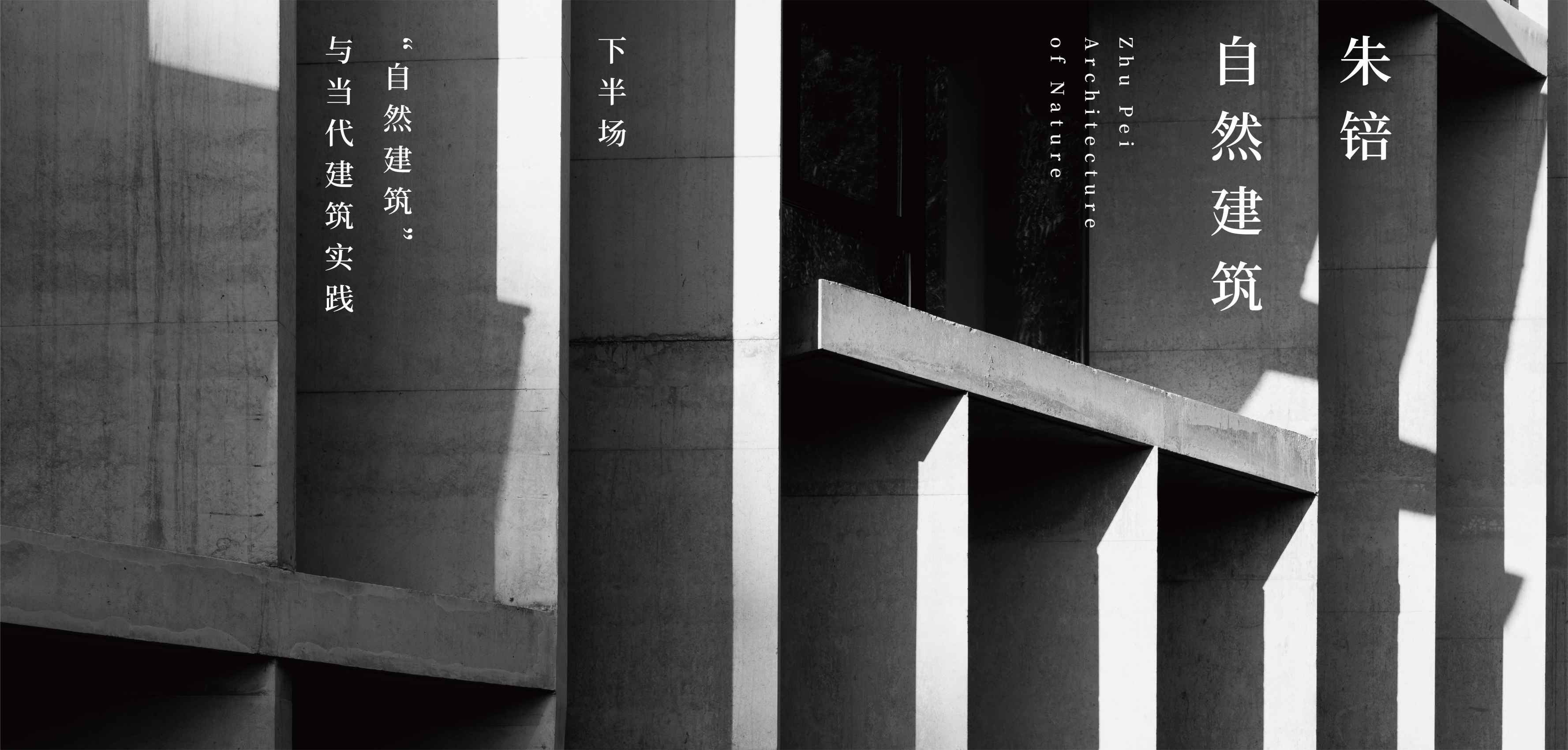
The second half of the forum's theme was "Architecture of Nature and Contemporary Architectural Practice," hosted by architecture critic Professor Zhou Rong. Four guests, including art critic Mr. Lu Hong, renowned architects Mr. Liu Jiakun, Mr. Dong Gong, and Mr. Li Hu, explored the related topics of "Nature Architecture" and contemporary architectural practice.

Lu Hong:
The problems addressed in the contemporary architecture and contemporary art fields are quite similar. Since the 1980s, Chinese art has experienced cultural phenomena resulting from imitating and learning from Western art. That's why in my book "Contemporary Art History 2000-2019," I proposed the core concept of "sinicization" in Chinese art. Mr. Zhu has successfully addressed this issue by emphasizing the exploration of tradition, engaging in dialogues with local history and culture, and not simply reverting to traditional imitation but based on contemporary issues.On the other hand, as a museum director, I have a small suggestion regarding museum architecture. Many architectural designs for museums nowadays tend to focus on aesthetics, form, and lighting, while neglecting the functionality, flow, and other aspects of museums. As a result, valuable artworks may not be displayed effectively, and modifications made during use may not necessarily solve the problem. Mr. Zhu's architecture always emphasizes dialogue with history, nature, and functionality. Therefore, in this regard, I believe Mr. Zhu's architectural works provide inspiration for contemporary architects, even for Western architects.
Zhou Rong:
Mr. Lu Hong's speech touches upon a phenomenon in the architectural industry and education. Traditionally, architecture originated from the craftsmanship of artisans, starting with how to chisel a stone or saw a piece of wood. However, nowadays, education begins with concepts, training architects to create abstract concepts of space. As a result, architects today are like trees growing upside down, with initially large crowns and prestigious reputations, but they can only truly become themselves when their root systems reach the ground. Otherwise, the previous crowns are just shadows. Growing upside down takes time. Why do architects need to be in their forties or fifties? It's because they grow upside down and need to find their own ground. The first half of this forum discussed vast and limitless matters, while the second half focuses on grounding oneself to the land, discussing the deep essence of architecture as a craft.
Li Hu:
From the early Shenzhen Planning Bureau office building to these five recent projects, including the philosophical underpinnings of "Architecture of Nature," Professor Zhu deliberately departs from familiar expressions of the past and moves towards another direction. This is a process of grounding. These five projects show continuous experimentation, including the Yang Liping Performing Arts Center, which serves as a transitional piece between previous and current stages. It bridges the past and the future. The latest project, Majiayao, is undergoing changes. I can feel that Professor Zhu is exploring new structures, and the Nest is the first time I've heard about his concept. It is a creative work that presents clear spatial ideas. I look forward to seeing the trajectory of Professor Zhu's ever-evolving designs. From my own experience, architectural transformations can be subjective or passive, random or intentional. Sometimes, we often say that we do what we want to do, with both strong and weak functionality. Sometimes, the tasks themselves force or help us explore and address new problems. This may be the growth process of every architect.
Liu Jiakun:
I still remember Professor Zhu Pei's early work, the Guggenheim Art Pavilion in Abu Dhabi, which had a bold and striking sense of form. It could have been a valid direction for development, but it would have been relatively superficial. After so many years, Professor Zhu has presented these new works that are different in theory and what he creates now has substance. However, the previous works should not be negated because, after restraint and convergence, the elements of expressive forms are still present in all architecture and have even more power than before. I am highly anticipating the completion of Majiayao. I can sense the depth it exudes. All your choices, including the selection of structure, materials, and sensitivity to the surrounding context, are a result of delving into the depth. That's why they are visible. The combination of early experiences and current age has led to this state. At the same time, it has connected with your personality. Therefore, the transition to the creation of Majiayao might result in an explosive element. It's not a uniform progression, but after reaching that realm, it becomes another level.
Dong Gong:
The topic of "Architecture of Nature" today also resonates with the most challenging aspect of my daily architectural practice and operations. My understanding of nature is not just as a physical environment, the natural world we inhabit, but it also has a logic. In my view, it is a natural progression. Many of Professor Zhu's buildings can be articulated because, unlike artists, he can explain the architectures he designs. The reason he can explain them is that they contain a natural part, following a certain logic in the process of deconstruction. For me, this represents a state in which architectural design delves inward. It may not completely overlap with "grounding," but delving inward is a core aspect for architects. It is difficult to truly adhere to, especially in this era. Delving inward often remains unseen. Whether a building has spent a lot of time thinking about its precise logic behind the scenes cannot be easily discerned from photographs, but those knowledgeable in the field can perceive it. Nowadays, many architectural designs lack this level of questioning.Without the delving inward, the architecture will be blown away by the winds, carried away by the trends of the era. However, if it consists only of logical elements, it will lack the canopy and the poetic aspect. This is the strongest impression and impact I have gained from getting to know Zhu Pei's architecture over such a long period, including his exhibition and the exhibition itself.
Qing Feng:
As a theoretical researcher, I am more concerned with concepts from a work perspective. The concept of primacy, which was mentioned earlier, is a crucial concept. Growing upward presents many possibilities, but where the roots are anchored determines where growth can occur. Growing from the top down is problematic. Whether architects, theoretical workers, or even artists, that deep layer always delves downward. When returning to the source, you don't know how deep the source is, nor should you know because if you know everything, it wouldn't be a source anymore. However, every additional centimeter of delving deeper adds a centimeter of thickness to the earth. Regardless of whether it is through words, architecture, or artistic creation, it appears to be growing upward on the surface. However, what truly nourishes it is the part that delves deep. It is necessary to continually explore the source, to explore how to creatively excavate these origins. That's my impression.
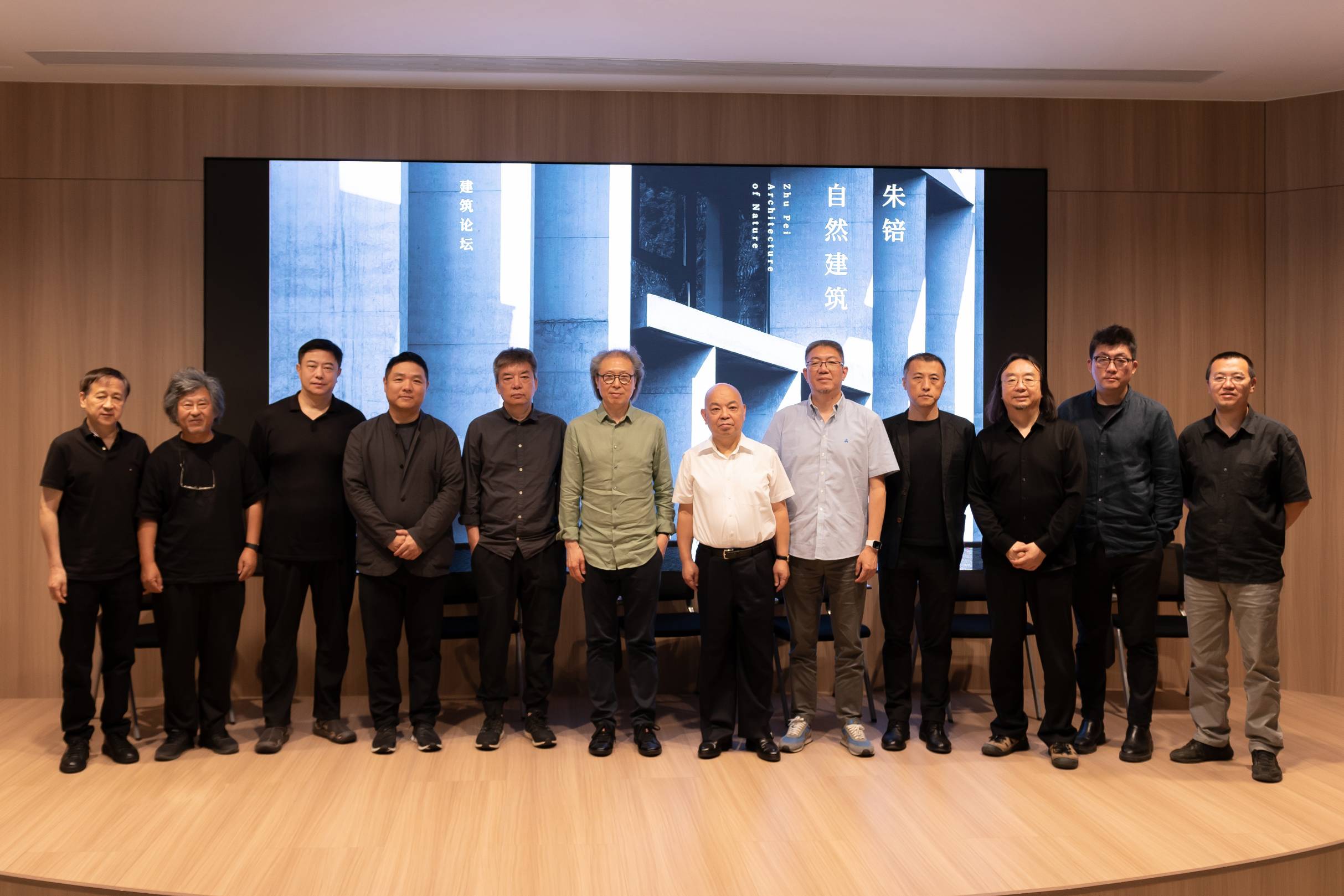
Professor Zhou Rong made a final statement on "Architecture of Nature" and the present era during the closing session of the forum. In an age of skepticism, where nothing can be taken for granted and no definitive path lies before us, we have no choice but to use an axe to open the door. What was once considered foolish may now be our method. This method returns to a state of simplicity, and in Chinese history, it is known as "kung fu." Modern people are unwilling to put in the effort and instead seek clear shortcuts to efficient solutions. However, when we suddenly realize that such shortcuts do not actually exist, we are forced to return to "kung fu." What does it mean for an architect to be "skilled"? It means dedicating 30 years of effort and presenting it in a few design works, allowing us to perceive the precious value beyond language.
In reality, Professor Zhu Pei's exhibition takes us into a world of "kung fu," with its horizontal and vertical elements, presenting authenticity. Many people may come to a halt in front of this threshold of "kung fu" and only a few can cross it, continuing to move forward in a vertical state.

The exhibition features five representative works of "Architecture of Nature" by Zhu Pei in recent years, including the Jingdezhen Imperial Kiln Museum, Majiayao Ruins Museum and Observatory, OCT Art Center, Zijing International Conference Camp, and the Yangliping Performing Arts Center. These projects are situated in diverse natural environments and each carries a unique and profound cultural history. Despite their distinct locations, they are united by their distinctive structures, materials, architectural forms, and spatial configurations. With a spirit of "celebration" and "humility," they are embedded in the earth, collectively embodying the infinite richness and creative potential of the "Architecture of Nature" theory and expressing the pursuit of "poetic dwelling" between heaven and earth.

Majiayao Ruins Museum and Observatory
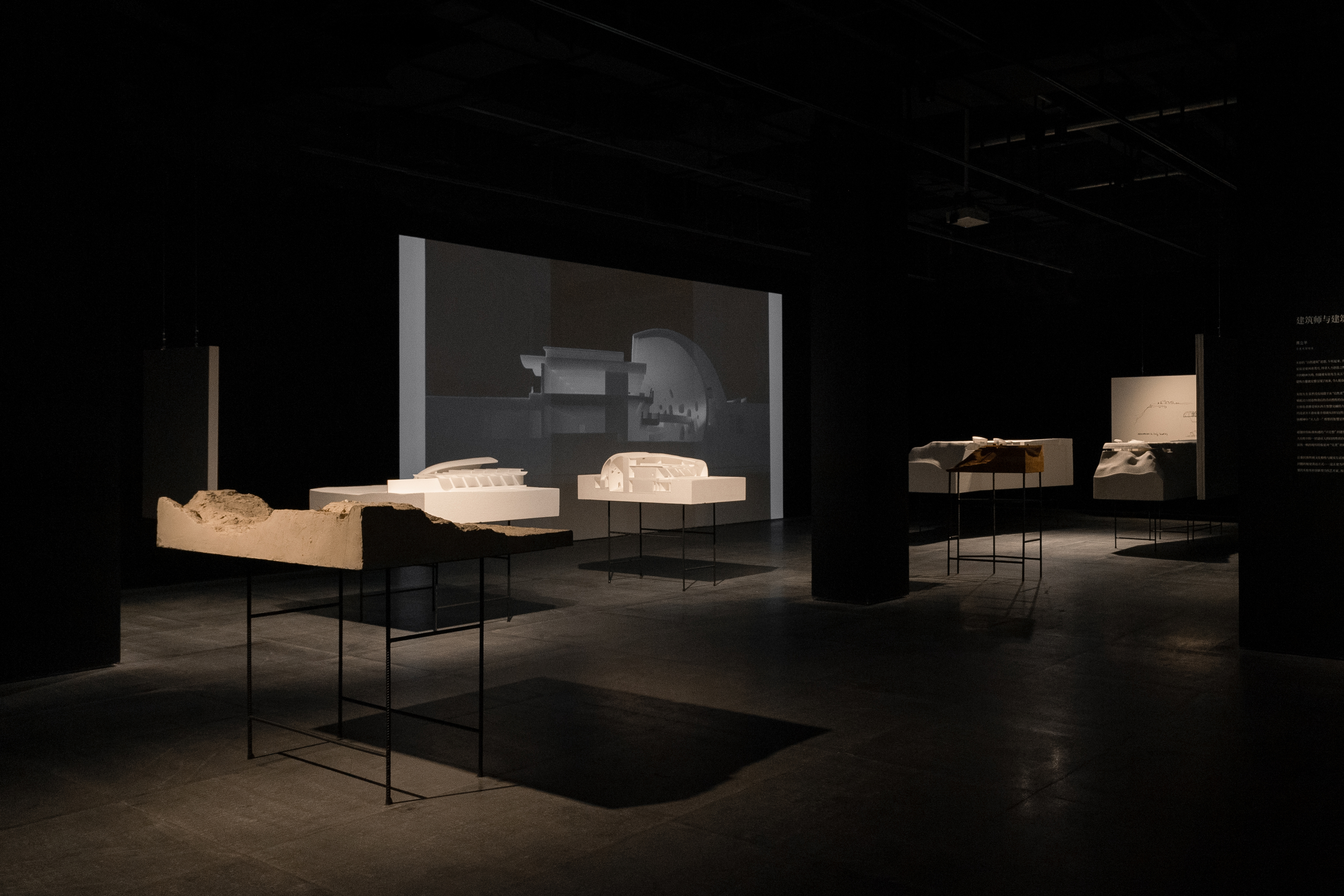
Majiayao ruins are located in Lintao County, Gansu Province, at the intersection of Taohe River and its tributary Bamayu canyon. It belongs to the ancient settlement site from Neolithic Age to Bronze Age. In 1924, Swedish geologist Andersen discovered the Majiayao site on the west bank of Taohe River in Lintao County. Along with the excavation of a large number of painted pottery vessels, it has been proved to be the most important prehistoric civilization in the upper reaches of the Yellow River in the late Neolithic period, and is known as Majiayao Culture.

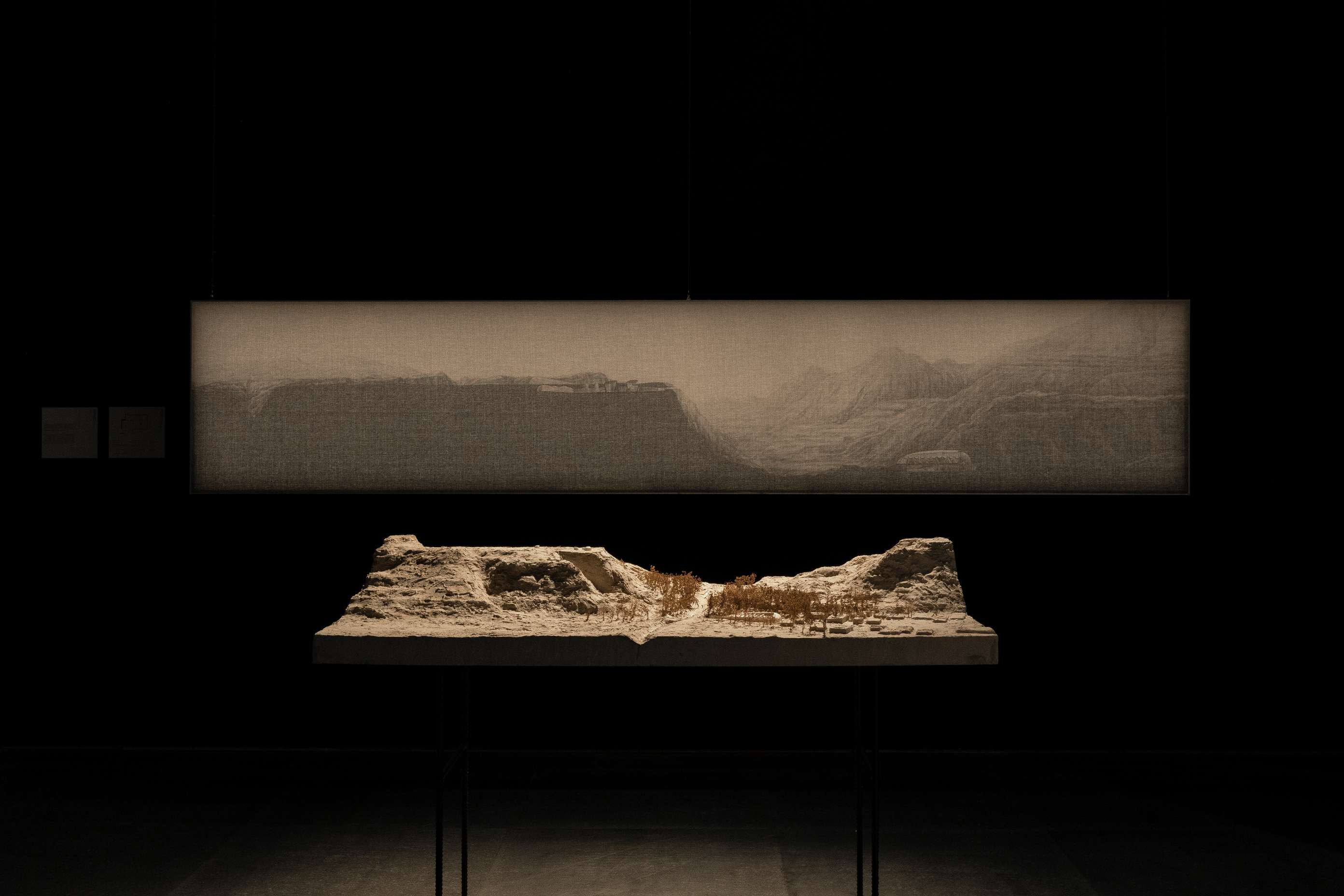
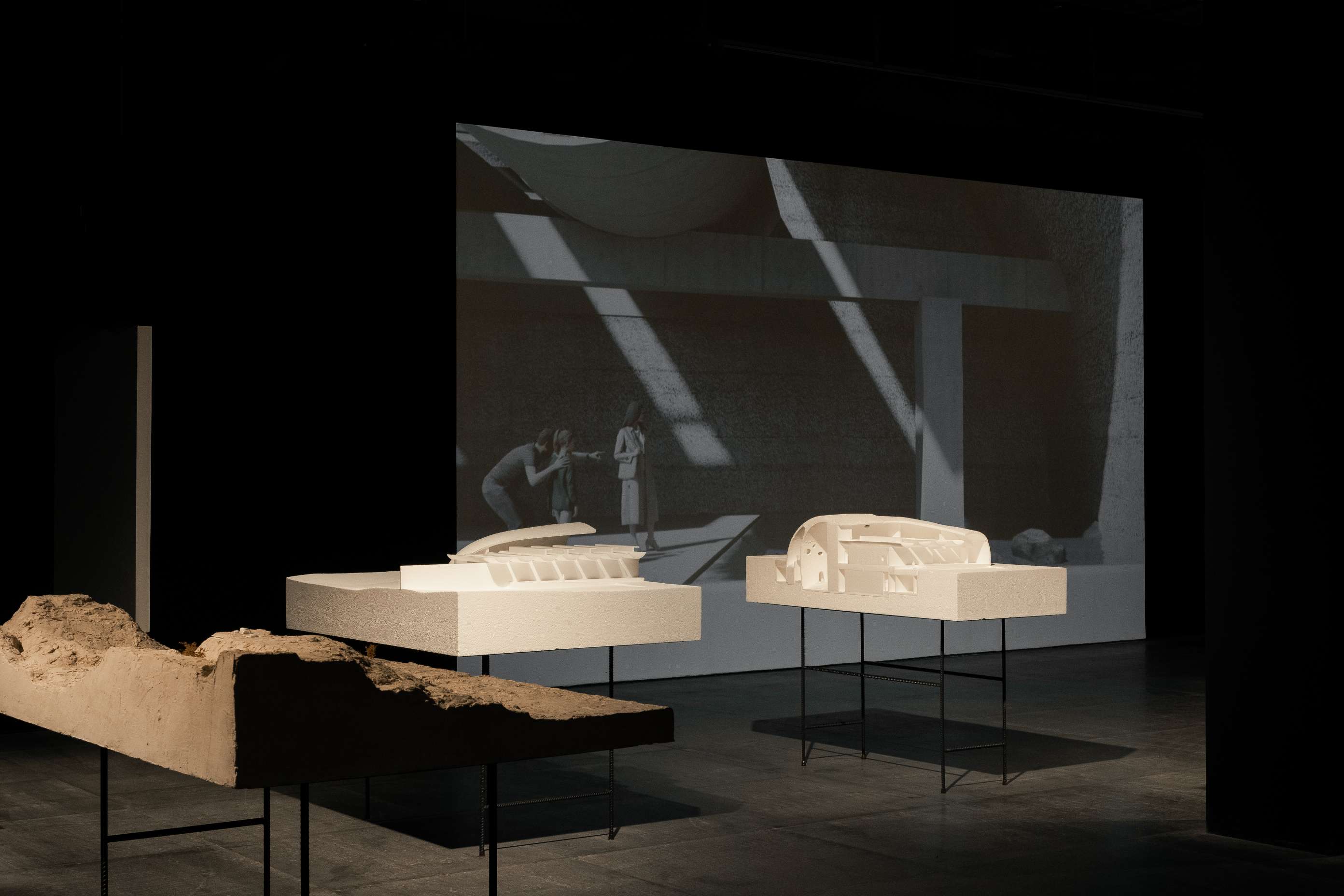
Jingdezhen Imperial Kiln Museum

The Museum, a porcelain museum focusing on Imperial Kiln artifacts, is located in the center of the historical area in Jingdezhen, adjacent to the Imperial Kiln Ruins of Ming Dynasty. It is surrounded by various historical buildings, including old houses, traditional kilns, factories, and residential buildings of the late 1990s. Those buildings have shaped a rich and diverse urban fabric and formed a unique site with enriching historical contexts.

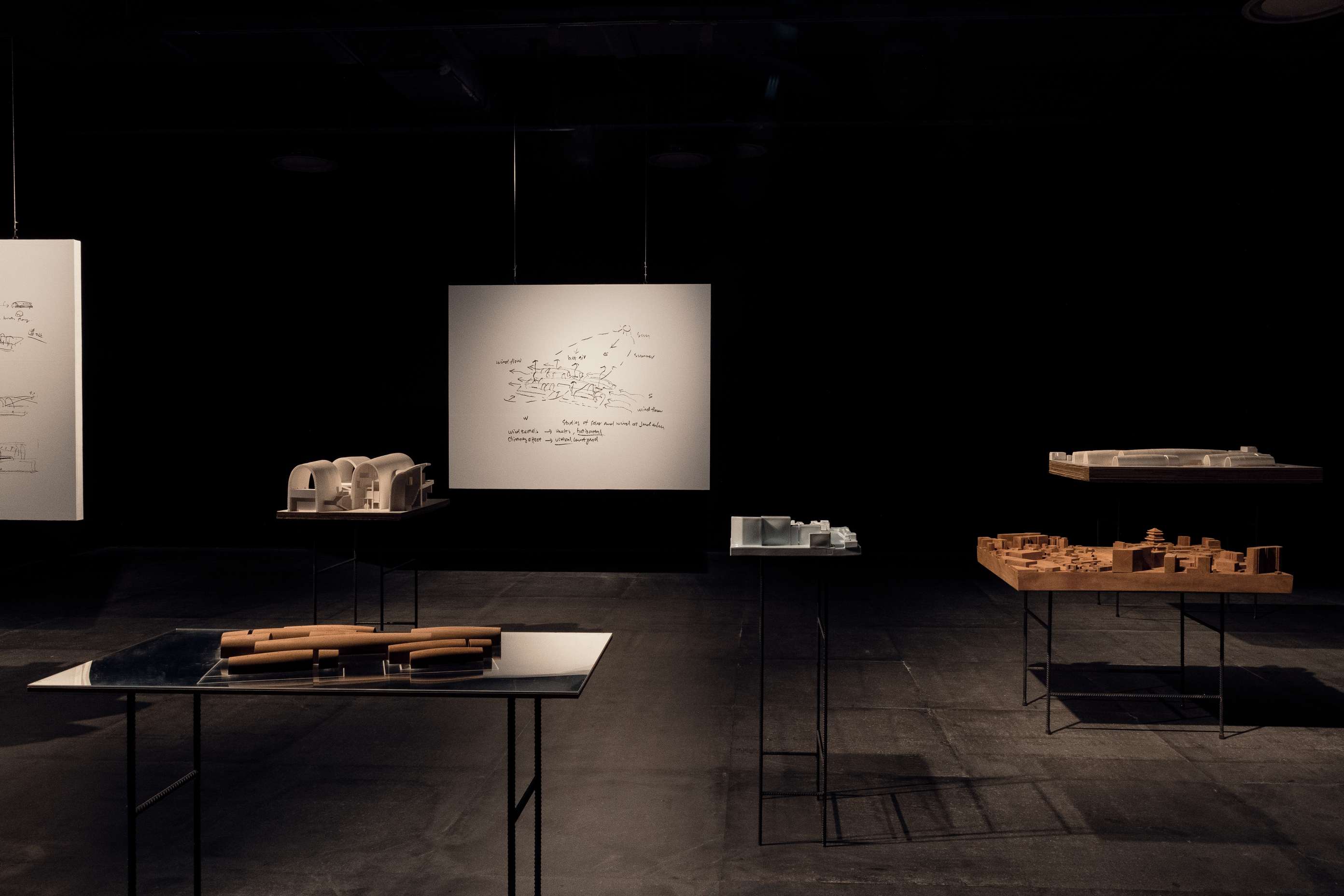
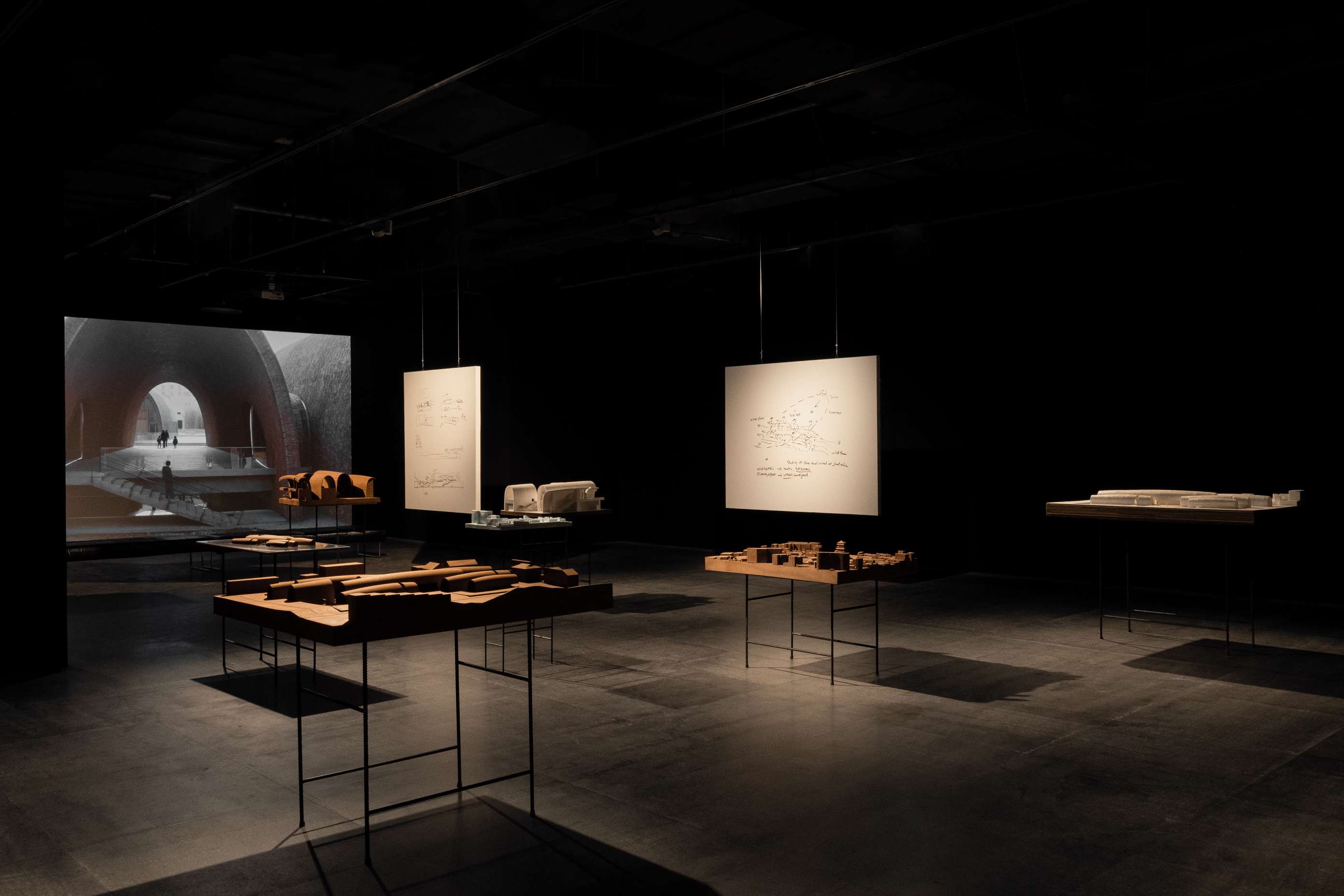
Zijing International Conference Camp
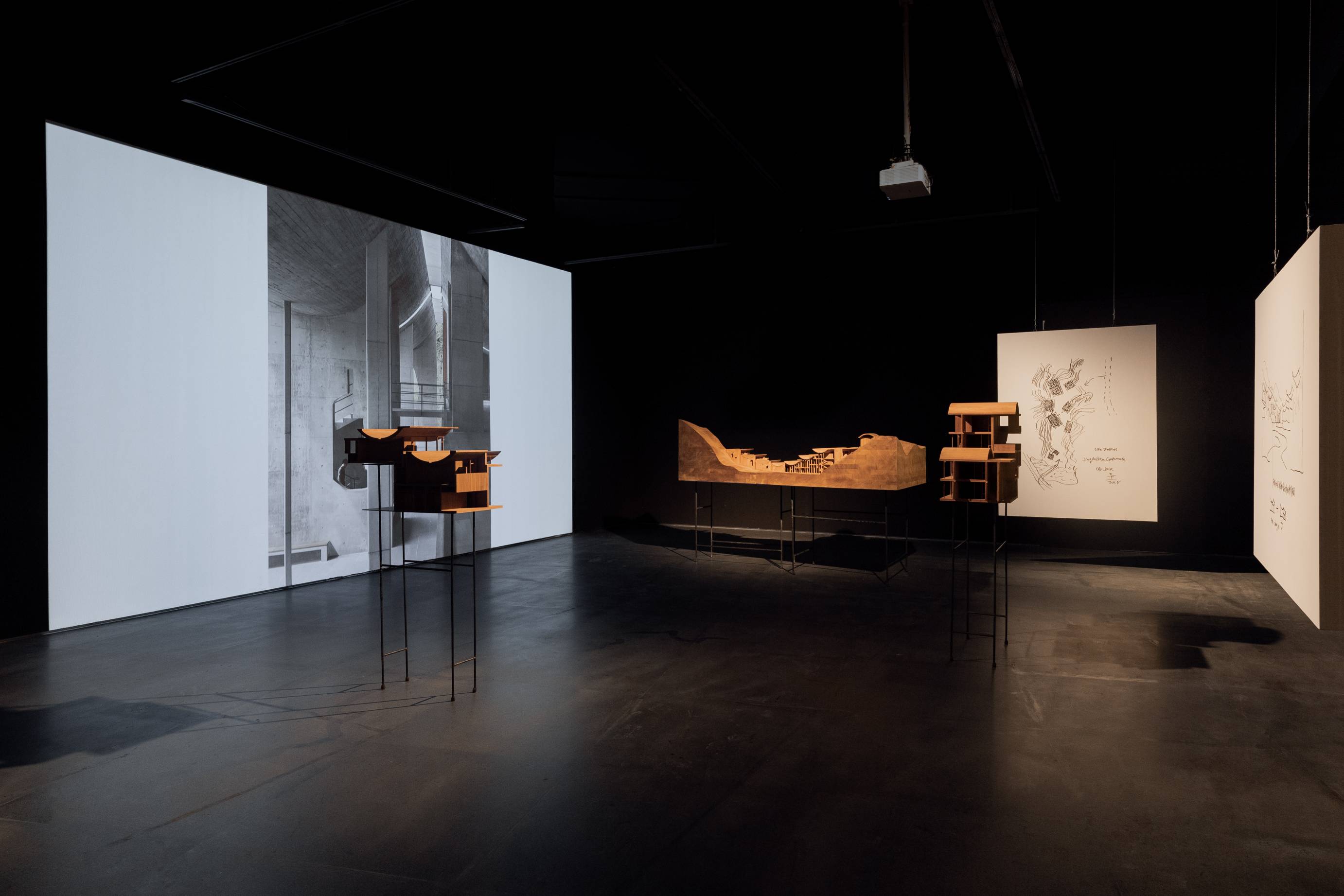
Zijing International Conference Camp is located in the mountains and ravines on the west side of Jingdezhen, Jiangxi. The site was originally a primitive and natural mountain valley with dense forests. Then it became a large narrow, extended field created by people cutting down mountains and filling ravines.
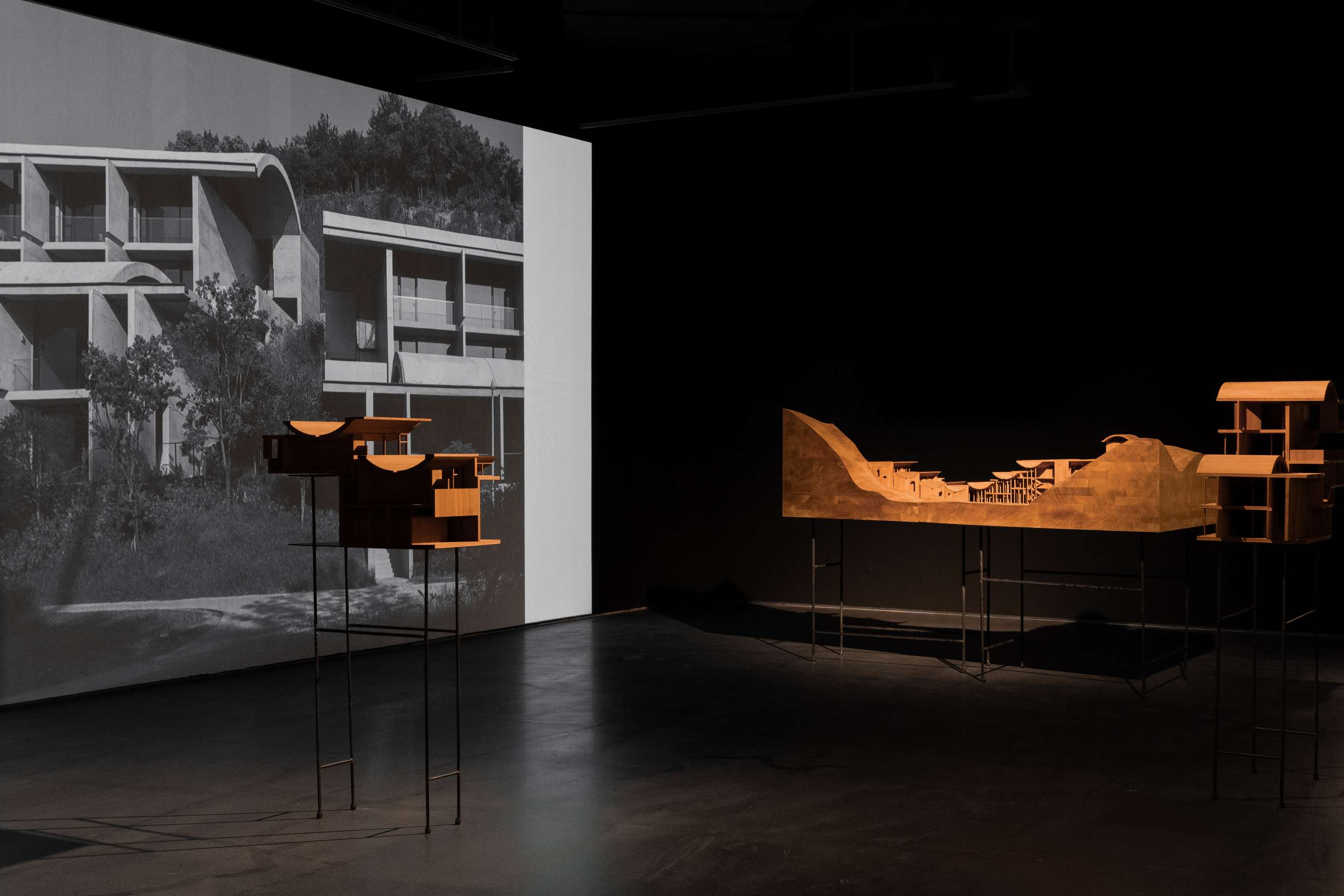
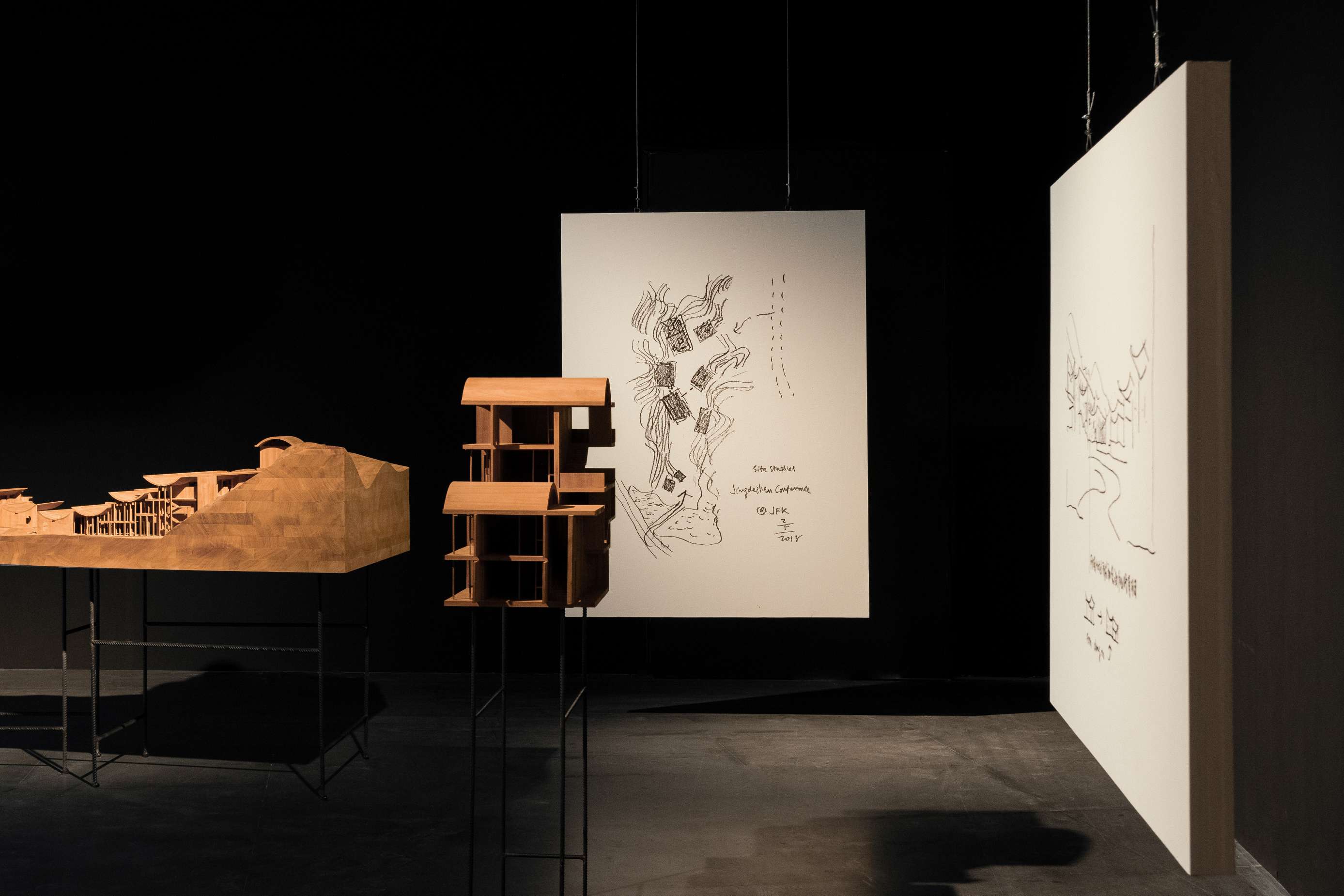
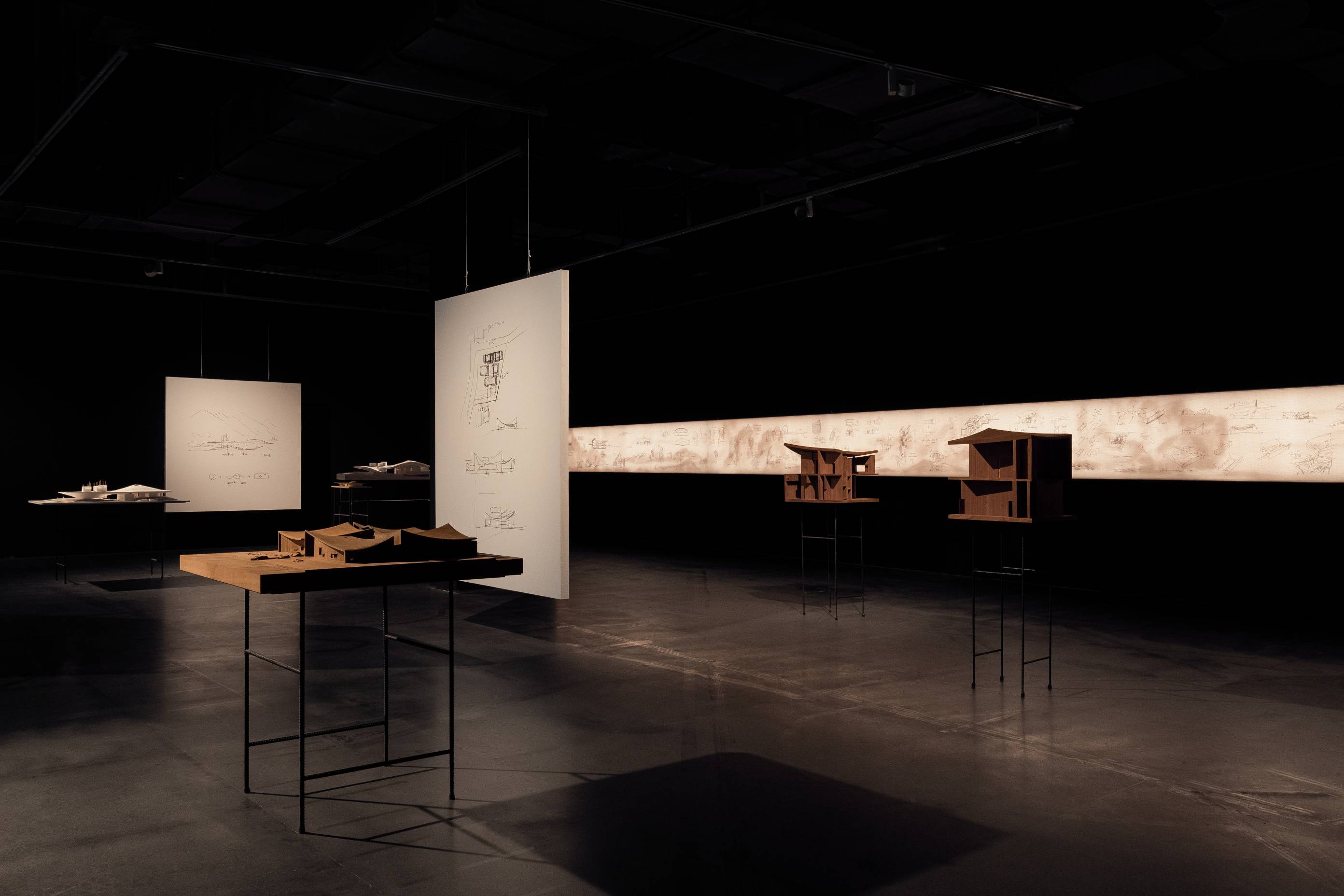
Zibo Art Center, an introverted experimental work, is located in an open area far away from the city. Its architectural form is conceived from the traditional Chinese academy-“Heyuan”, a central courtyard was surrounded by several houses.
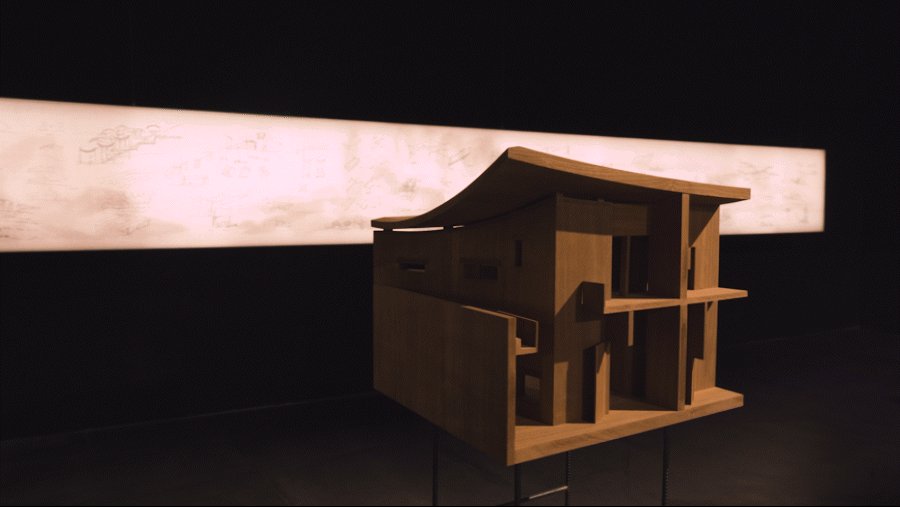

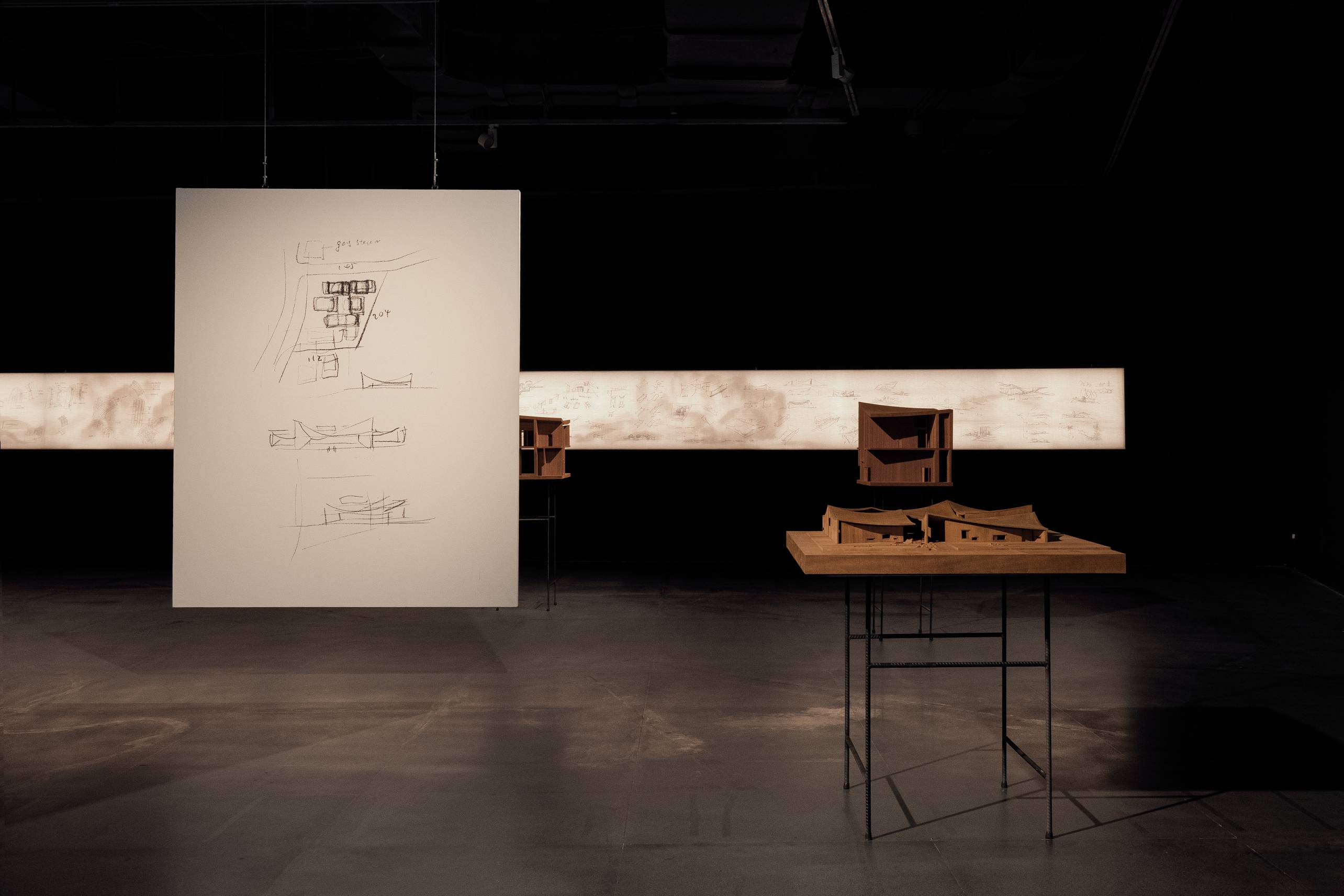
Yangliping Performing Arts Center
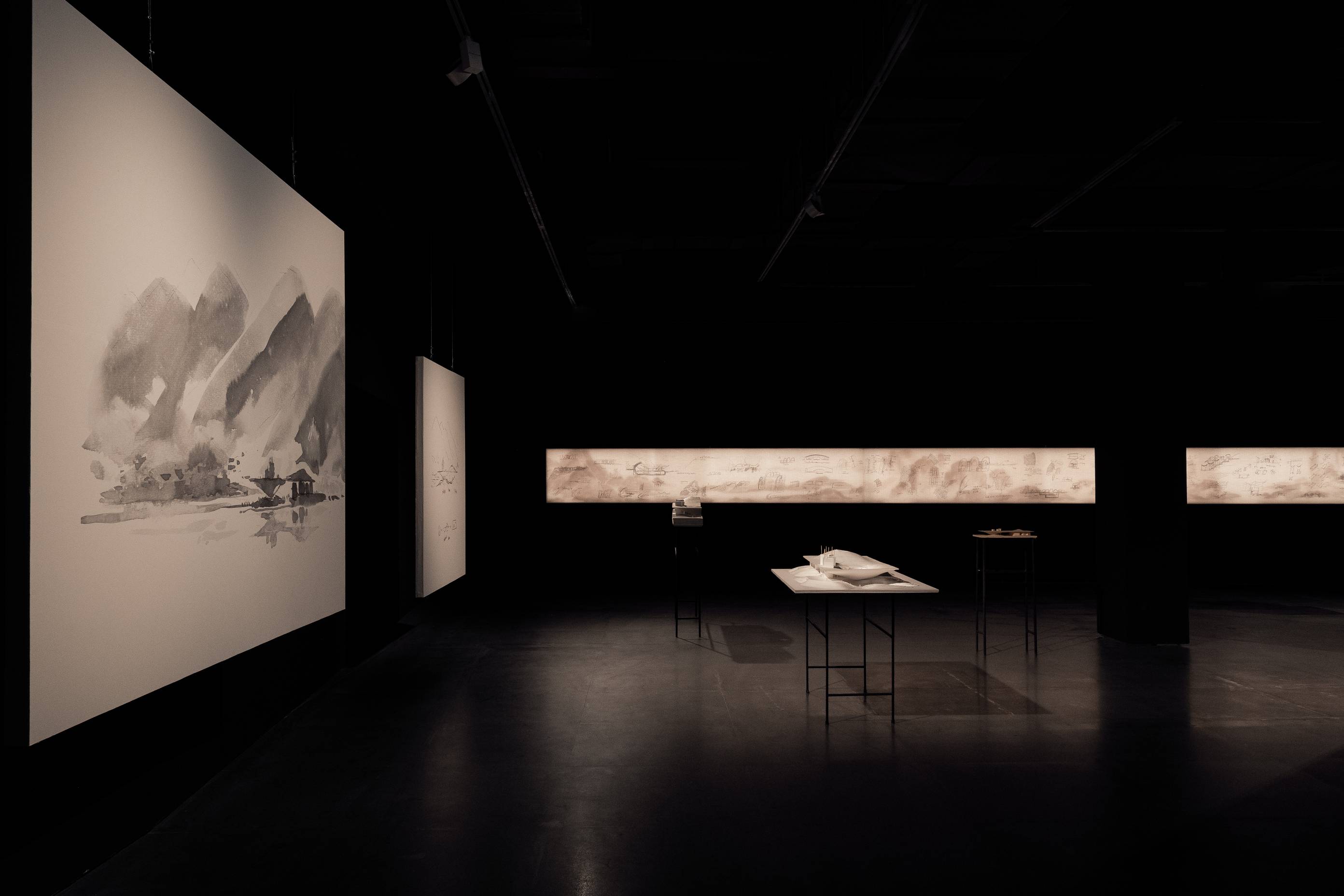
Situated between the Cang mountain chain which reaches 4,000 meters in height, and the 40 kilometers long Lake Erhai, the city of Dali, a significant stop of the ancient tea and horse road, is an important tourism destination. The old town has largely preserved and still has some remains of the historic city wall with gate towers.
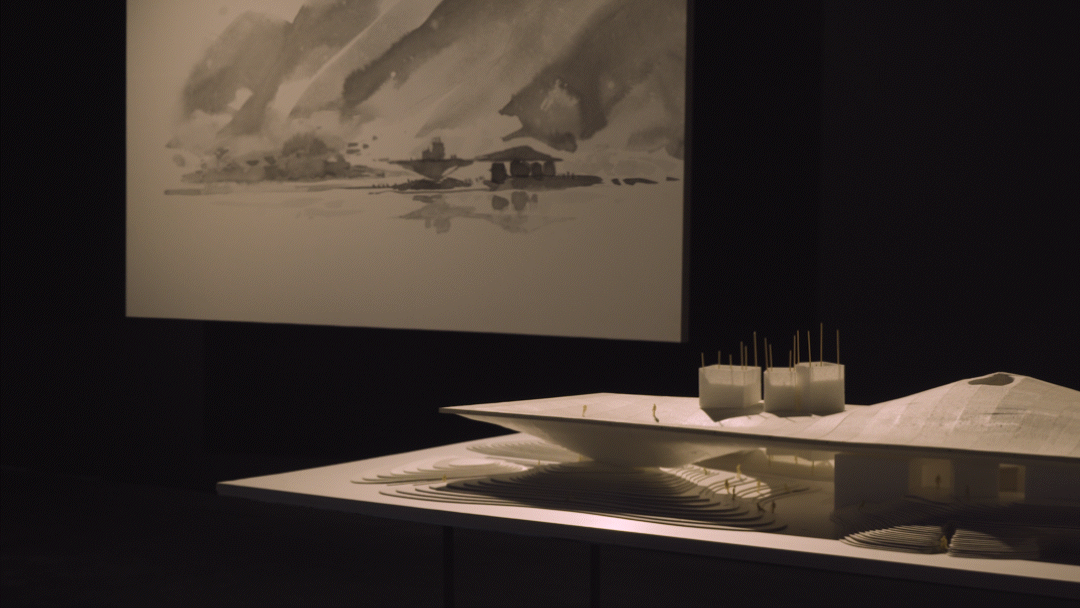
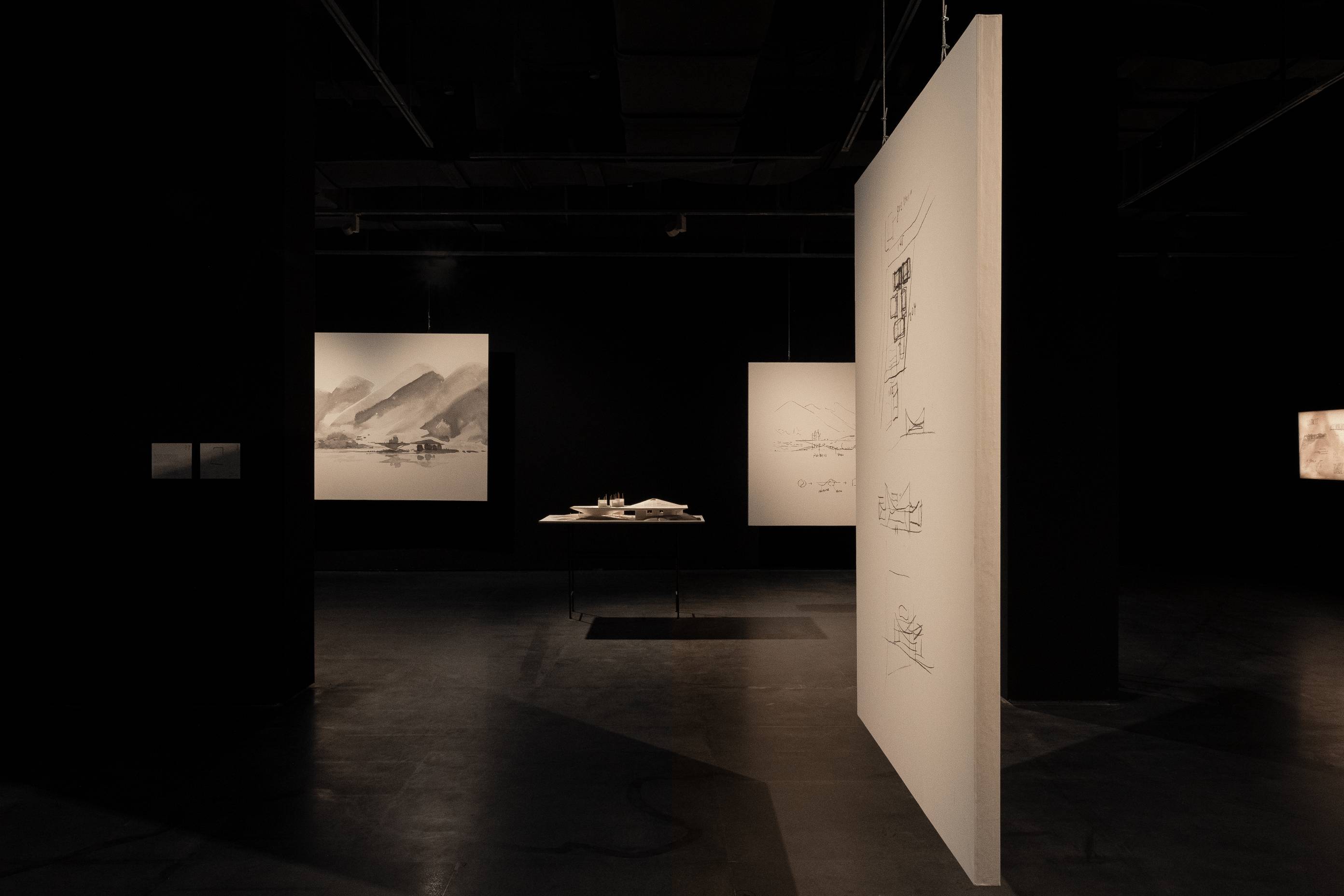

Project name: "Architecture of Nature" solo exhibition by Zhu Pei
Duration: 2023
Curator: Wang Mingxian
Producer: Huang Liping
Academic Host: Lu Hong
Exhibition design: Studio Zhu Pei
Design Team: Liu Yian, Wang Siqi, Wang Junqi, Wang Yiru, Li Yumeng, Zhang Wantong, Shen Minqi, Gu Yuanzhen, Liu Pei, Wei Sitong, Li Junlin
Exhibition Assistants: Hong Mei, Xia Yaoyao
Exhibition Copywriter: Tang Rushing
Architectural Photography: Wang Junqi, Gu Yuanzhen, Wei Sitong
Visual Design Consultant: Studio TODO
Exhibition Committee: Huang Liping, Lu Hong, Yao Hua, Gan Xingsong, Hong Mei, Ai Xiao Zheng, Wang Weiqi, Sun Jiangshu, Qian Jinxin, Hu Lu, Zhou Yifan
Exhibition Support: China Construction First Bureau (Group) Company Limited, China Construction First Bureau Huajiang Construction Company Limited, Beijing Extraordinary Spatial Art Design Company Limited, Beijing Oriya New Energy Technology Co.
The opening ceremony and forum of the "Architecture of Nature" solo exhibition by Zhu Pei were successfully held at the He Art Museum in Wuhan.
2023.07.20
On June 29, 2023, the "Architecture of Nature" solo exhibition by Zhu Pei opened at the United Art Museum in Wuhan. This is the first solo exhibition in China by the renowned architect Mr. Zhu Pei, and also the first solo exhibition by an architect that the United Art Museum has held in its nine years of establishment.


In the opening speech, Mr. Huang Liping, the director of the United Art Museum, first reviewed the history of the museum's establishment and the initial intention of choosing to establish a contemporary art museum as an entrepreneur. It was not only to promote the sustainable development of enterprises based on culture, but also to truly participate in current social development and life, to promote future-oriented art development with the spirit of daring to doubt and breakthrough. In nearly a decade of its history, the museum has held solo exhibitions for 22 contemporary artists and has also gradually realized the importance of contemporary architecture during this process. Therefore, the idea of hosting a series of solo exhibitions for contemporary architects has become increasingly mature. The decision to choose Mr. Zhu Pei as the representative architect for the first exhibition was because they saw in Zhu Pei's works the criticality and transcendence that is in line with the spirit of contemporary art. The contemplation on culture and the Eastern view of nature embodied in his works holds particularly enlightening significance in the present day.

Mr. Fan Dian, Chairman of the China Artists Association, was also invited to attend the opening ceremony and gave a speech. He highly praised Zhu Pei's experimental architectural creations and the concept of "Architecture of Nature" from a theoretical and academic perspective:"Mr. Zhu Pei is a world-renowned Chinese architect. For many years, he has persisted in theoretical thinking and exploration, and has demonstrated the cultural thinking, cultural vision, and relentless exploration of contemporary Chinese architects through a large number of architectural practices. Many of his works are showcased in this exhibition, forming an elegant academic atmosphere through models, manuscripts, and images, and are particularly artistically appealing.In my view, Zhu Pei is a very typical architect who crosses cultural boundaries. He has carried out exchanges from China to the United States and many other places around the world, conducted teaching, and formed project collaborations. However, his architectural practice is always rooted in the land of China. He has deeply studied the expression of Chinese traditional architectural thoughts, concepts, and cultural spirit in contemporary architecture, forming an architectural concept based on his own cultural tradition.The concept of "Architecture of Nature" he proposed is of significant importance for us today in reviving Chinese culture in the field of architecture. Just as Director Huang Liping just said, we have many experimental and exploratory architectural practices, which need to become more inclusive and a broader frontier trend in architecture as a whole today. Mr. Zhu Pei has given us profound enlightenment in this regard."
Mr. Fan Dian summarized three important features of Mr. Zhu Pei's architectural philosophy and practice:
First, the exploration of "Architecture of Nature" not only associates architecture with nature but also relates it more closely with human culture. This makes "humanistic nature" further enrich the connotation of "nature" in terms of cultural capacity and texture.
Second, "Architecture of Nature" is the crystallization of combining function with cultural thinking and then exploring. It integrates architectural function with natural culture using the language of architecture, and manifests it with creative spatial expressions, thus unfolding infinite spiritual dwellings in a limited space.
Third, "Architecture of Nature" conducts in-depth exploration and groundbreaking inheritance of traditional Chinese construction methods and material applications from the perspective of specific construction techniques.



Mr. Wang Mingxian, the curator of this exhibition, was unable to attend the event in person. Ms. Yao Hua, the deputy director of the United Art Museum, delivered the opening speech on his behalf. The speech reviewed the historical background of the emergence of "Architecture of Nature" from a historical perspective and reiterated the significance of the theory of "Architecture of Nature" - it represents a rare experiment in world contemporary architecture, and an important supplement to the world's architectural theory.
In his speech at the opening ceremony, the exhibiting architect Mr. Zhu Pei mentioned: "During the past decade or so of experimental creation, I have always adhered to my architectural philosophy -- the theory of 'Architecture of Nature'. It is based on the cultural perspective and my perception of natural landscapes and human construction culture. 'Architecture of Nature' is, on one hand, a poetics of construction culture. On the other hand, it is also a response to two major challenges faced by humans today -- 'global climate change' and 'regional cultural disruption' -- based on traditional Eastern philosophy of nature."
"The 'Architecture of Nature' solo exhibition at the United Art Museum in Wuhan is, on one hand, a continuation of the thoughts on 'Architecture of Nature' derived from various domestic and international exhibitions I have participated in, including the 'Yi Garden' at the 2010 Venice Biennale, 'Mind Landscapes' in Berlin in 2017, 'Transformation' at the Imperial Kiln Museum in Jingdezhen in 2020, and 'Reuse, Renew, Recycle: Recent Architecture from China' at the MoMA (Museum of Modern Art) in New York last year. On the other hand, it is also a reflection, introspection, and summary of my own architectural creation process in recent years."
He first expressed his gratitude to Mr. Huang Liping, the director of the United Art Museum, and Mr. Lu Hong, the executive director, as well as their excellent team, for inviting him to hold a solo architecture exhibition at the United Art Museum - the forefront of contemporary art in China. He thanked them for their attention to contemporary Chinese architecture and appreciated their experimental, critical perspective and courage.
He specifically mentioned: "Looking back at my experimental creation and teaching career, I sincerely thank Mr. Fan Dian and Mr. Wang Mingxian for their long-term support, help, and guidance in the past twenty-plus years of teacher-student and friendly interaction. It is their long-term help and encouragement that allowed me to focus on contemporary art and draw energy from it, gain inspiration between contemporary architecture and contemporary art, and form my own distinctive creative language. I also want to thank Professor Zhou Rong for the criticism and help given to my experimental creative works over the past thirty years of friendship."
Lastly, I want to thank my colleagues, companions in my studio, and my students from the Central Academy of Fine Arts. It is your outstanding work and talented creativity that have made today's exhibition possible. Thank you all.

At the end of the opening ceremony, a donation ceremony was held, during which Mr. Zhu Pei accepted the donation certificate issued by Director Huang Liping.

On the morning of the opening ceremony, the "Architecture of Nature" Forum was also held. Renowned scholars, architects, critics, and artists from across the country gathered to express their views on the related topics of "Architecture of Nature". Through these exchanges, the concept of "Architecture of Nature" was more fully explored.
Mr. Zhu Pei first led the guests on a tour of the exhibition, emphasizing that the "Architecture of Nature" solo exhibition held at the United Art Museum in Wuhan is a continuation of the concept of "Architecture of Nature" embodied in several exhibitions at home and abroad, including "Yi Garden" at the 2010 Venice Biennale, "Mind Landscapes" in Berlin in 2017, "Transformation" at the Imperial Kiln Museum in Jingdezhen in 2020, and "Reuse, Renew, Recycle: Recent Architecture from China" at MoMA in New York in 2021. It is also a reflection and summary of his own architectural creative process in recent years. He mentioned: The creative process of architects is different from that of most artists. Artists often create facing their own final works, while architects can only create with the aid of media. In this "Architecture of Nature" solo exhibition, only three media - sketches, models, and images - are used to realistically and artistically reproduce the creative process of the architect and the thought behind the works.


At the beginning of the forum, Mr. Zhu Pei gave a keynote speech, in which he elaborated on the theory of "Natural Architecture" in conjunction with five exhibited works. "Natural Architecture" is a realization by Zhu Pei based on a cultural perspective on natural landscapes and human construction culture. On one hand, it is a construction poetics; on the other hand, it is a response to the common challenges faced by humans: global climate change and regional cultural disruption, both of which are responses rooted in Eastern natural philosophy. What it explores is the underlying construction principle of architecture, seeking a kindred relationship between people, nature, and culture. Its ultimate goal is to explore the poetic dwelling of human beings in the world.

"Rootedness" and "Creativity" are the dual paths from theory to practice in "Natural Architecture". On one hand, by excavating roots, architecture can be grounded in a certain specific climate and cultural soil. On the other hand, a creative attitude allows architecture to shape an open system that accommodates many new possibilities and creates new experiences. "Rootedness" is not only about digging into and understanding the past of past things, but more importantly, it's about understanding the present nature of past things. If an architectural work does not have the "rootedness" of historical consciousness, it would be like having no fulcrum in the vast cosmic space, incapable of leveraging the existing architectural thought system, hence there would be no talk of "creativity".
To be specific, "Natural Architecture" proposes to examine architecture from five dimensions, which are: 1. Site and Orientation, 2. Structure and Form, 3. Sponge Architecture, 4. Cave and Nest, 5. Incomplete Integrity. These dimensions not only reveal the profound blood relationship between traditional culture and contemporary architectural creation from the perspectives of construction and technology, but also from the perspective of culture. The deep relationship reflected by these dimensions is our attitude towards humans, nature, and tradition. In the current context where architecture is increasingly polarized between theme-parkization and commodification, it is particularly important to maintain a historical view that respects nature, tradition, and the history of humans themselves.

The first half of the forum, themed "Natural Architecture from a Cultural Perspective", was chaired by Professor Li Xiangning, the dean of the School of Architecture at Tongji University. The four guests, hailing from fields of architectural history and theory, architectural media, mass media, and contemporary art, expressed their views and understandings of "Natural Architecture" from various perspectives.

Li Xiangning:
Contemporary architecture often holds great appeal for contemporary artists, leading them to be eager to engage in architectural creation. As a curator of a contemporary art museum, how do you view the practice of contemporary architecture in China? And how do you evaluate Zhu Pei's "Architecture of Nature"?
Huang Liping:
Firstly, you mentioned the idea of contemporary artists wanting to replace architectural design, but this is probably more of an artistic imagination because architecture, apart from its artistic aspects, also has functional and economic needs. Without considering these aspects, architecture cannot be realized.
From the perspective of an art museum, as knowledge creators producing knowledge, we hope that contemporary art not only does not overlook architecture but also gives it sufficient status because what is influencing this era is likely not only painting and sculpture but to a large extent, architecture. In this sense, "Architecture of Nature" is something we eagerly anticipate as a narrative theme that can be found through Eastern culture and spirit. The "Incomplete Integrity" dimension in the five dimensions of "Architecture of Nature" establishes a connection with the "non-necessity" that I have greatly admired in the past. If everything is necessary, there would be no art because art arises from the non-necessary. In this respect, we find a common ground in our thinking, and this exhibition is a very good start. I hope it can continue and contribute to Chinese architectural culture and practice.
Li Xiangning:
Different from architectural media, Sanlian Lifeweek pays more attention to the relationship between architecture and society and people - what impact does it have on local residents or users? What significance does it have in changing the overall urban human ecology? From this perspective, as the editor-in-chief of Sanlian Lifeweek, how do you evaluate Zhu Pei's architecture?
Li Honggu:
In a sense, architecture is the fundamental basis for narrating a region and a city. Whether architecture can serve as the source for telling the so-called Chinese story and urban story, Zhu Pei has done a very powerful job. Take Jingdezhen as an example. The previous narrative of being the "Millennium Porcelain Capital" was actually broken in terms of time because the Millennium Porcelain Capital neither led to the emergence of commercial civilization nor achieved the realization of scaled commodity production, resulting in the city not finding its own narrative roots and sources. I believe that it was only after the completion of the design works by Zhang Jie and Zhu Pei that the urban narrative of Jingdezhen was fundamentally reconstructed, turning to its own cultural roots. History in their construction is continuous, inherent, and self-consistent. Specifically, in the design of the Jingdezhen Imperial Kiln Museum, it delves into the internal structure of kilns rather than just the porcelain itself. It respects and draws wisdom from traditional construction, returning to the continuity of local tradition and the development of porcelain production itself. It integrates into the urban context and fabric, rather than being a monument-like abrupt presence. At the same time, on the other hand, it is both innovative and poetic in terms of structure, occurring in the present with historical significance, providing a future that is both continuous and open, creative and uncertain.
The concept mentioned by Zhu Pei in his exposition of "Architecture of Nature" is crucial, which is the "presentness in the past." I remember when I first met Zhu Pei at the Jingdezhen Imperial Kiln Museum, I asked him why the two ends of the kiln structure were connected. His answer was very simple: for convenient ventilation. This straightforward response struck me as having a Zen-like quality. As a person from the southern region, it embodies the most basic and simple knowledge of southern life. From this, I understand that the "rootedness" in "Architecture of Nature" actually lies in these local and ordinary traditions, and this is also the aspect that truly moves ordinary people like me living in such a city.
Li Xiangning:
Professor Zhi, you are conducting research on the genealogy of Chinese architects, observing the professional ideas and academic trajectories of architects. Zhu Pei's early works in the Shenzhen Planning Bureau and the Shenzhen OCT Art Center are very different from his current works. From your observation of the development of an architect's career, why did Zhu Pei undergo such a transformation?
Zhi Wenjun:
Looking at Zhu Pei's generation from the perspective of contemporary Chinese architecture, as the fourth generation of architects, they were fortunate to have many opportunities, such as studying abroad after the reform and opening up and later participating in the great wave of Chinese architecture. In my opinion, Zhu Pei is an excellent architect based on the core of modernist architectural space. The "Architecture of Nature" he currently speaks of not only presents the fundamental characteristics of modernist space but also gradually explores new aspects such as the extension of space as a body and the expression of spatial history and culture. Compared to the early Shenzhen Planning Bureau Office Building, as a modern architecture, it expresses something different in terms of the history, climate, culture of the local area, and the intensity of space he currently speaks of. As a creative subject, architects have endless possibilities in their thinking about the infinite potential of each individual's mind-body experience and the pursuit of sensory perception of space. But as long as a building evokes emotions in people, and these emotions come from the unique value of its local history and culture, then it is a great architecture.
Li Xiangning:
Zhu Pei analyzed "Cave and Nest" as types or prototypes of architecture. Cave and nest represent two architectural models in the West, reflecting two different relationships between human beings and nature in the process of survival. One relies on nature, using caves to provide a warm environment, and the other is when nature does not provide, humans build using branches. These two have a certain opposing or complementary pattern, similar to the Platonic model in philosophy, where the cave is used as a metaphor for humans, actually confined within their own narrow cognition. For architecture, it also faces this issue, on one hand, its own cognition, and on the other hand, its understanding of nature. To some extent, Zhu Pei's exploration is the struggle or search for balance between the two extremes. Please share your understanding of this issue.
Qing Feng:
This question has many theoretical clues, and the question itself is very inspiring. "Nature" is the most traditional concept in architecture, and the entire classical theory is built on the concept of natural order, which continued until the Renaissance. The Renaissance also studied nature and understood it as an absolute order. Therefore, creation is not so arbitrary; one must find this absolute theory and present it.The concept of nature has changed throughout history. In the 18th century, philosophers like John Locke and Jean-Jacques Rousseau discussed nature as the natural state of humans, as innate competition or human nature being inherently good. Therefore, in Marc-Antoine Laugier's Primitive Hut, it is humans who construct, rather than the rules imposed by the heavens. At this time, the concept had shifted from an absolute natural order to the natural state of humans, and humans became the dominant force. Since then, modern science has been built on human-led science.In "Architecture of Nature," an important concept is rootedness, and Martin Heidegger's understanding of nature is actually about rootedness, which he calls the “spring”. Heidegger used the concepts of sky and earth because they are closest to nature. The term "Nature" that we use today is borrowed from Japan; before that, it was translated as sky and earth, which is closer to Heidegger. The difference between them is that most scientific explanations of nature today, analyzed through technological perspectives, can't explain many things. Although they can't explain them, they still serve as a source, which makes people feel that we should maintain a sense of humility and respect. "Architecture of Nature" also mentions the concept of incomplete integrity, and its roots lie here. Incompleteness is inevitable because it comes from nature. Nature, in Western etymology, means birth, it comes from the word embryo. It is something that is born, not something created out of nothing. Today, the most common understanding of artists is that they are creators, but in reality, the only true creator out of nothing is God. If we are not God, we cannot do it. Regardless of materials, structures, or traditions, they are the sources that we cannot escape. On the other hand, precisely because we have this source, the work has a foundation and profound connotations that can be understood and communicated, thereby constituting a kind of completeness from another perspective. From this perspective, concepts like "Architecture of Nature," including the five related factors mentioned earlier, are very important. We are not just talking about architectural design techniques, but rather, from a fundamental level, reflecting on nature, architecture, and humans existing between heaven and earth. Why does Zhu Pei present such rich connotations recently? It is closely related to this depth of reflection.
Li Xiangning:
When discussing natural construction with Wang Shu, because Chinese and English do not distinguish word types, when we talk about "nature," it could refer to the natural environment or the logic, nature, and essence that it conforms to. In fact, "Architecture of Nature" or construction can be understood as the relationship with the natural environment, including wind, air, water, soil, mountains, and also reflects the essential nature of what a building should have, which allows people to settle and survive within it. This is a broader understanding of "Architecture of Nature."

The second half of the forum's theme was "Architecture of Nature and Contemporary Architectural Practice," hosted by architecture critic Professor Zhou Rong. Four guests, including art critic Mr. Lu Hong, renowned architects Mr. Liu Jiakun, Mr. Dong Gong, and Mr. Li Hu, explored the related topics of "Nature Architecture" and contemporary architectural practice.

Lu Hong:
The problems addressed in the contemporary architecture and contemporary art fields are quite similar. Since the 1980s, Chinese art has experienced cultural phenomena resulting from imitating and learning from Western art. That's why in my book "Contemporary Art History 2000-2019," I proposed the core concept of "sinicization" in Chinese art. Mr. Zhu has successfully addressed this issue by emphasizing the exploration of tradition, engaging in dialogues with local history and culture, and not simply reverting to traditional imitation but based on contemporary issues.On the other hand, as a museum director, I have a small suggestion regarding museum architecture. Many architectural designs for museums nowadays tend to focus on aesthetics, form, and lighting, while neglecting the functionality, flow, and other aspects of museums. As a result, valuable artworks may not be displayed effectively, and modifications made during use may not necessarily solve the problem. Mr. Zhu's architecture always emphasizes dialogue with history, nature, and functionality. Therefore, in this regard, I believe Mr. Zhu's architectural works provide inspiration for contemporary architects, even for Western architects.
Zhou Rong:
Mr. Lu Hong's speech touches upon a phenomenon in the architectural industry and education. Traditionally, architecture originated from the craftsmanship of artisans, starting with how to chisel a stone or saw a piece of wood. However, nowadays, education begins with concepts, training architects to create abstract concepts of space. As a result, architects today are like trees growing upside down, with initially large crowns and prestigious reputations, but they can only truly become themselves when their root systems reach the ground. Otherwise, the previous crowns are just shadows. Growing upside down takes time. Why do architects need to be in their forties or fifties? It's because they grow upside down and need to find their own ground. The first half of this forum discussed vast and limitless matters, while the second half focuses on grounding oneself to the land, discussing the deep essence of architecture as a craft.
Li Hu:
From the early Shenzhen Planning Bureau office building to these five recent projects, including the philosophical underpinnings of "Architecture of Nature," Professor Zhu deliberately departs from familiar expressions of the past and moves towards another direction. This is a process of grounding. These five projects show continuous experimentation, including the Yang Liping Performing Arts Center, which serves as a transitional piece between previous and current stages. It bridges the past and the future. The latest project, Majiayao, is undergoing changes. I can feel that Professor Zhu is exploring new structures, and the Nest is the first time I've heard about his concept. It is a creative work that presents clear spatial ideas. I look forward to seeing the trajectory of Professor Zhu's ever-evolving designs. From my own experience, architectural transformations can be subjective or passive, random or intentional. Sometimes, we often say that we do what we want to do, with both strong and weak functionality. Sometimes, the tasks themselves force or help us explore and address new problems. This may be the growth process of every architect.
Liu Jiakun:
I still remember Professor Zhu Pei's early work, the Guggenheim Art Pavilion in Abu Dhabi, which had a bold and striking sense of form. It could have been a valid direction for development, but it would have been relatively superficial. After so many years, Professor Zhu has presented these new works that are different in theory and what he creates now has substance. However, the previous works should not be negated because, after restraint and convergence, the elements of expressive forms are still present in all architecture and have even more power than before. I am highly anticipating the completion of Majiayao. I can sense the depth it exudes. All your choices, including the selection of structure, materials, and sensitivity to the surrounding context, are a result of delving into the depth. That's why they are visible. The combination of early experiences and current age has led to this state. At the same time, it has connected with your personality. Therefore, the transition to the creation of Majiayao might result in an explosive element. It's not a uniform progression, but after reaching that realm, it becomes another level.
Dong Gong:
The topic of "Architecture of Nature" today also resonates with the most challenging aspect of my daily architectural practice and operations. My understanding of nature is not just as a physical environment, the natural world we inhabit, but it also has a logic. In my view, it is a natural progression. Many of Professor Zhu's buildings can be articulated because, unlike artists, he can explain the architectures he designs. The reason he can explain them is that they contain a natural part, following a certain logic in the process of deconstruction. For me, this represents a state in which architectural design delves inward. It may not completely overlap with "grounding," but delving inward is a core aspect for architects. It is difficult to truly adhere to, especially in this era. Delving inward often remains unseen. Whether a building has spent a lot of time thinking about its precise logic behind the scenes cannot be easily discerned from photographs, but those knowledgeable in the field can perceive it. Nowadays, many architectural designs lack this level of questioning.Without the delving inward, the architecture will be blown away by the winds, carried away by the trends of the era. However, if it consists only of logical elements, it will lack the canopy and the poetic aspect. This is the strongest impression and impact I have gained from getting to know Zhu Pei's architecture over such a long period, including his exhibition and the exhibition itself.
Qing Feng:
As a theoretical researcher, I am more concerned with concepts from a work perspective. The concept of primacy, which was mentioned earlier, is a crucial concept. Growing upward presents many possibilities, but where the roots are anchored determines where growth can occur. Growing from the top down is problematic. Whether architects, theoretical workers, or even artists, that deep layer always delves downward. When returning to the source, you don't know how deep the source is, nor should you know because if you know everything, it wouldn't be a source anymore. However, every additional centimeter of delving deeper adds a centimeter of thickness to the earth. Regardless of whether it is through words, architecture, or artistic creation, it appears to be growing upward on the surface. However, what truly nourishes it is the part that delves deep. It is necessary to continually explore the source, to explore how to creatively excavate these origins. That's my impression.

Professor Zhou Rong made a final statement on "Architecture of Nature" and the present era during the closing session of the forum. In an age of skepticism, where nothing can be taken for granted and no definitive path lies before us, we have no choice but to use an axe to open the door. What was once considered foolish may now be our method. This method returns to a state of simplicity, and in Chinese history, it is known as "kung fu." Modern people are unwilling to put in the effort and instead seek clear shortcuts to efficient solutions. However, when we suddenly realize that such shortcuts do not actually exist, we are forced to return to "kung fu." What does it mean for an architect to be "skilled"? It means dedicating 30 years of effort and presenting it in a few design works, allowing us to perceive the precious value beyond language.
In reality, Professor Zhu Pei's exhibition takes us into a world of "kung fu," with its horizontal and vertical elements, presenting authenticity. Many people may come to a halt in front of this threshold of "kung fu" and only a few can cross it, continuing to move forward in a vertical state.

The exhibition features five representative works of "Architecture of Nature" by Zhu Pei in recent years, including the Jingdezhen Imperial Kiln Museum, Majiayao Ruins Museum and Observatory, OCT Art Center, Zijing International Conference Camp, and the Yangliping Performing Arts Center. These projects are situated in diverse natural environments and each carries a unique and profound cultural history. Despite their distinct locations, they are united by their distinctive structures, materials, architectural forms, and spatial configurations. With a spirit of "celebration" and "humility," they are embedded in the earth, collectively embodying the infinite richness and creative potential of the "Architecture of Nature" theory and expressing the pursuit of "poetic dwelling" between heaven and earth.

Majiayao Ruins Museum and Observatory

Majiayao ruins are located in Lintao County, Gansu Province, at the intersection of Taohe River and its tributary Bamayu canyon. It belongs to the ancient settlement site from Neolithic Age to Bronze Age. In 1924, Swedish geologist Andersen discovered the Majiayao site on the west bank of Taohe River in Lintao County. Along with the excavation of a large number of painted pottery vessels, it has been proved to be the most important prehistoric civilization in the upper reaches of the Yellow River in the late Neolithic period, and is known as Majiayao Culture.



Jingdezhen Imperial Kiln Museum

The Museum, a porcelain museum focusing on Imperial Kiln artifacts, is located in the center of the historical area in Jingdezhen, adjacent to the Imperial Kiln Ruins of Ming Dynasty. It is surrounded by various historical buildings, including old houses, traditional kilns, factories, and residential buildings of the late 1990s. Those buildings have shaped a rich and diverse urban fabric and formed a unique site with enriching historical contexts.



Zijing International Conference Camp

Zijing International Conference Camp is located in the mountains and ravines on the west side of Jingdezhen, Jiangxi. The site was originally a primitive and natural mountain valley with dense forests. Then it became a large narrow, extended field created by people cutting down mountains and filling ravines.



Zibo Art Center, an introverted experimental work, is located in an open area far away from the city. Its architectural form is conceived from the traditional Chinese academy-“Heyuan”, a central courtyard was surrounded by several houses.



Yangliping Performing Arts Center

Situated between the Cang mountain chain which reaches 4,000 meters in height, and the 40 kilometers long Lake Erhai, the city of Dali, a significant stop of the ancient tea and horse road, is an important tourism destination. The old town has largely preserved and still has some remains of the historic city wall with gate towers.



Project name: "Architecture of Nature" solo exhibition by Zhu Pei
Duration: 2023
Curator: Wang Mingxian
Producer: Huang Liping
Academic Host: Lu Hong
Exhibition design: Studio Zhu Pei
Design Team: Liu Yian, Wang Siqi, Wang Junqi, Wang Yiru, Li Yumeng, Zhang Wantong, Shen Minqi, Gu Yuanzhen, Liu Pei, Wei Sitong, Li Junlin
Exhibition Assistants: Hong Mei, Xia Yaoyao
Exhibition Copywriter: Tang Rushing
Architectural Photography: Wang Junqi, Gu Yuanzhen, Wei Sitong
Visual Design Consultant: Studio TODO
Exhibition Committee: Huang Liping, Lu Hong, Yao Hua, Gan Xingsong, Hong Mei, Ai Xiao Zheng, Wang Weiqi, Sun Jiangshu, Qian Jinxin, Hu Lu, Zhou Yifan
Exhibition Support: China Construction First Bureau (Group) Company Limited, China Construction First Bureau Huajiang Construction Company Limited, Beijing Extraordinary Spatial Art Design Company Limited, Beijing Oriya New Energy Technology Co.